
Alfred Stevens
Belgian Artist
1823 - 1906

Alfred Stevens was born in Brussels. He came from a family involved with the visual arts: his older brother Joseph (1816-1892) and his son Léopold (1866-1935) were painters, while another brother Arthur (1825-99) was an art dealer and critic. His father, who had fought in the Napoleonic wars in the army of William I of the Netherlands, was an art collector who owned several watercolors by Eugène Delacroix, among other artists. His mother's parents ran Café de l'Amitié in Brussels, a meeting place for politicians, writers, and artists. All the Stevens children benefited from the people they met there, and the social skills they acquired in growing up around important people.
After the death of his father in 1837, Stevens left middle school to begin study at the Académie Royale des Beaux-Arts in Brussels, where he knew François Navez, the Neo-Classical painter and former student of Jacques-Louis David who was its director and an old friend of Stevens' grandfather. Following a traditional curriculum, he drew from casts of classical sculpture for the first two years, and then drew from live models. In 1843, Stevens went to Paris, joining his brother Joseph who already was there. He was admitted to the École des Beaux-Arts, the most important art school in Paris. Although it is said that he became a student of its director Jean Auguste Dominique Ingres, this is likely not true. An early picture by Stevens, The Pardon or Absolution (Hermitage, St. Petersburg), signed and dated 1849, shows his mastery of a conventional naturalistic style which owes much to 17th-century Dutch genre painting. Like the Belgian painter and friend with whom he stayed in Paris, Florent Joseph Marie Willems (1823-1905), Stevens carefully studied works by painters such as Gerard ter Borch and Gabriel Metsu.

Stevens' work was shown publicly for the first time in 1851, when three of his paintings were admitted to the Brussels Salon. He won a third-class medal at the Paris Salon in 1853, and a second-class medal at the Universal Exposition in Paris in 1855. His Ce qu'on appelle le vagabondage (What is called vagrancy) (Musée d'Orsay, Paris) attracted the attention of Napoleon III who, as a result of the scene in the picture, ordered that soldiers no longer be used to pick up the poor from the streets. Two other paintings he exhibited at the Salon in Antwerp that year, Chez soi or At Home (present location unknown) and The Painter and his Model (Walters Art Museum, Baltimore), introduced subjects from "la vie moderne" for which he became known: an elegant young woman in contemporary dress and the artist in his studio. In 1857, Stevens made his first important sale to a private collector, when Consolation was bought for a rumored 6,000 francs by the Berlin collector and dealer Ravéné. At the same time, he and his brother were becoming part of the art world of Paris, meeting people such as the Goncourt brothers, Théophile Gautier, and Alexandre Dumas at the salons of Princess Mathilde as well as popular cafés. In 1858, Stevens married Marie Blanc, who came from a rich Belgian family and old friends of the Stevens'. Eugène Delacroix was a witness at the ceremony.
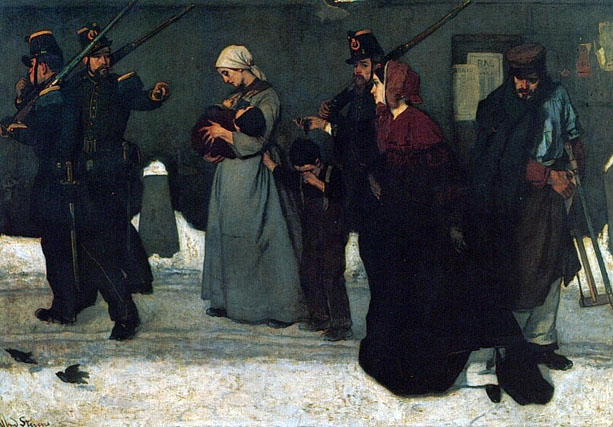
Born in Brussels in 1823, the Belgian painter Alfred Stevens moved to Paris in the 1840s. This painting is representative of the early part of his career, when he was keen to represent the squalor of the time in realist paintings.
This Parisian street is the setting for an urban drama. Soldiers lead a mother and her ragged children away to prison for the crime of vagrancy. An elegant woman is trying to intercede with the soldiers, while an old, invalid workman has already given up. The attempt is doomed to failure as shown by the soldier's gesture of refusal. A similar scene can be found in Victor Hugo's Things Seen.
On the long grey wall, posters referring to property sales ("sale by auction") and the pleasures of high society ("ball"), contrast with the poverty described in the painting. The different social groups who occupy the same urban space find themselves side by side here in a moving composition, and the role of the State, purely repressive, does not come out well.
Stevens' objective was to denounce the poor living conditions in the towns and the cruel treatment meted out to those who lived there. The message struck a chord with Napoleon III who, on seeing this painting at the 1855 Universal Exhibition, supposedly said: "That will not happen again". As a consequence of this, the Emperor ordered that any vagrants should henceforth be taken to the Conciergerie, not on foot, but hidden away in a closed carriage.
Quoted From: Musée d'Orsay: Alfred Stevens - What is called Vagrancy
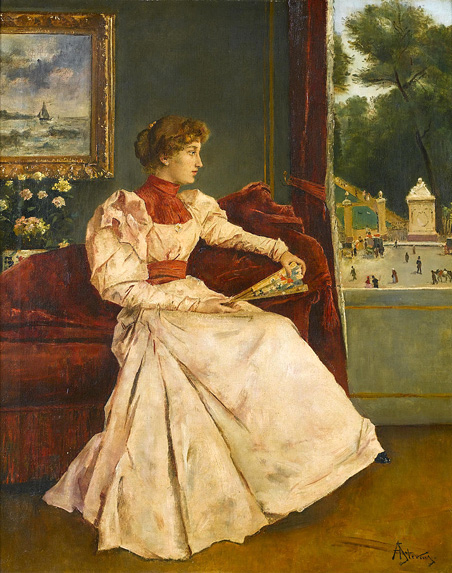
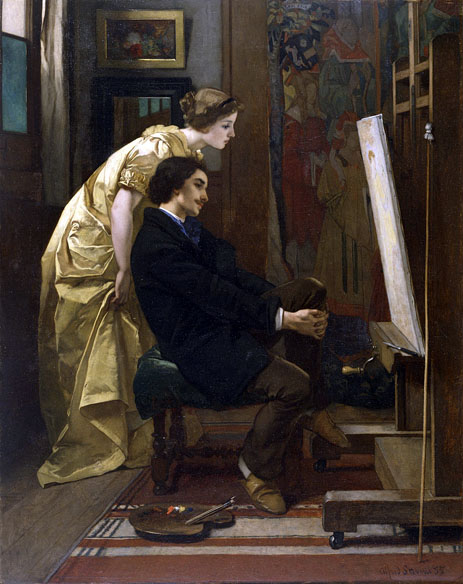
Stevens, a native of Brussels, spent much of his career in Paris where he was regarded as one of the most important recorders of the bourgeois and aristocratic levels of la vie moderne. In this early work, a young woman leans over the shoulder of an artist, presumably Stevens himself, who is regarding his unfinished canvas on the easel. Hanging in the background of the studio is a Flemish tapestry showing an Adoration scene
Quoted From: The Painter and His Model - The Walters Art Museum
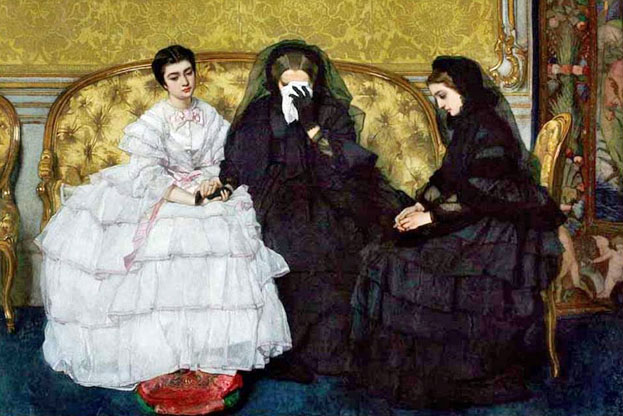
During the 1860s, Stevens became an immensely successful painter, known for his paintings of elegant modern women. His exhibits at the Salons in Paris and Brussels attracted favorable critical attention and buyers. An excellent example of his work during this time is La Dame en Rose or Woman in Pink (Musées royaux des Beaux-Arts de Belgique, Brussels), painted in 1866, which combines a view of a fashionably dressed woman in an interior with a detailed examination of Japanese objects, a fashionable taste called japonisme of which Stevens was an early enthusiast. In 1863, he received the Legion of Honor (Chevalier) from the Belgian government. In 1867, he won a first-class medal at the Universal Exposition in Paris, where he and Jan August Hendrik Leys were the stars of the Belgian section, and was promoted to Officer of the Legion of Honor. His friends included Edouard Manet, Edgar Degas, Charles Baudelaire, Berthe Morisot, James Abbott McNeill Whistler, Frédéric Bazille, and Puvis de Chavannes, and he was a regular in the group that gathered at the Café Guerbois in Paris.
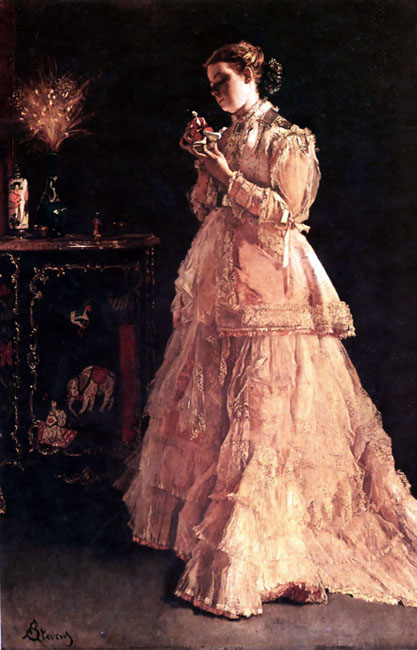
Stevens fought for the French during the siege of Paris in the Franco-Prussian War, but returned to Belgium with his wife and family before the Paris Commune. They returned after the war, and Stevens continued to achieve critical acclaim as well as great success with collectors. In 1875, he bought a grand house and garden in Paris on rue des Martyrs, which appeared in his paintings as well as those of other artists, including Edouard Manet's The Croquet Party (Städel Museum, Frankfurt am Main) from 1873. (He had to leave the house in 1880, however, to make way for the construction of a new street, which was named after him.) In 1878, he was made a Commander of the Legion of Honor and received another first-class medal at the Salon.
Despite earning a considerable income through the sale of his paintings, Stevens found that a combination of bad investments and excessive spending caused him great financial difficulties during the 1880s. An additional expense came from summers by the sea, which a doctor told Stevens in 1880 were essential for his health. Thus the artist was glad to agree when the Paris dealer Georges Petit offered him 50,000 francs to finance his vacation in exchange for the paintings Stevens produced during that time. This deal, which lasted for three years, resulted in the sea becoming an important subject for him, and over the rest of his career, he painted hundreds of views of popular resorts along the Normandy coast and the Midi in the south. Many of them are painted in a sketchy style that shows the influence of the Impressionists. Stevens also began to take private students, including Sarah Bernhardt, who became a close personal friend, and William Merritt Chase.
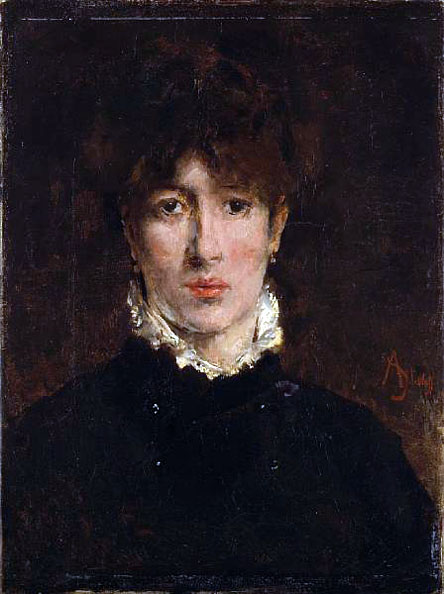
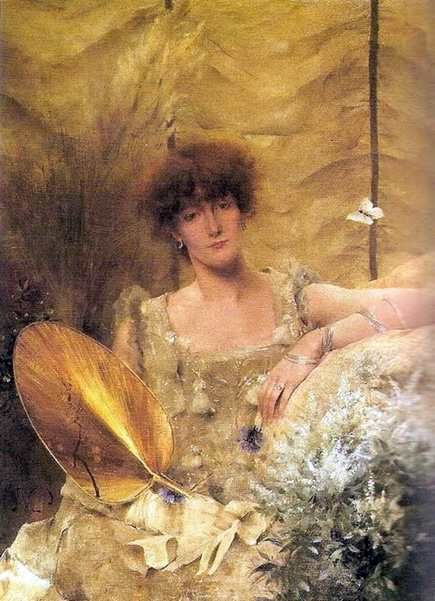
The single most important work from the second half of Stevens' career is the monumental Panorama du Siècle, 1789-1889, which he painted with Henri Gervex. Stevens painted the women and details and Gervex the men, with the help of fifteen assistants. It was shown to great acclaim at the International Exhibition held in Paris in 1889. He also received several great professional tributes. In 1895, a large exhibition of his work was held in Brussels. In 1900, Stevens was honored by the Ecole des Beaux-Arts in Paris with the first retrospective exhibition ever given to a living artist. Supported by patrons led by the Comtesse de Greffulhe, it achieved social cachet as well as popular success. In 1905, he was the only living artist allowed to exhibit in a retrospective show of Belgian art in Brussels. Despite these exhibitions, he was not able to sell enough of his work to manage well financially. Having outlived his brothers and most of his friends, he died in Paris in 1906, living alone in modest rooms.

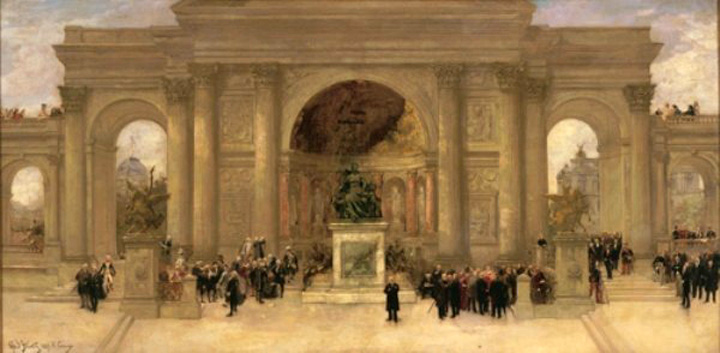
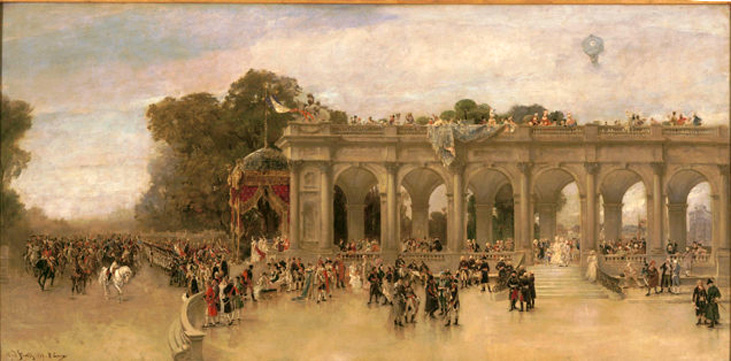
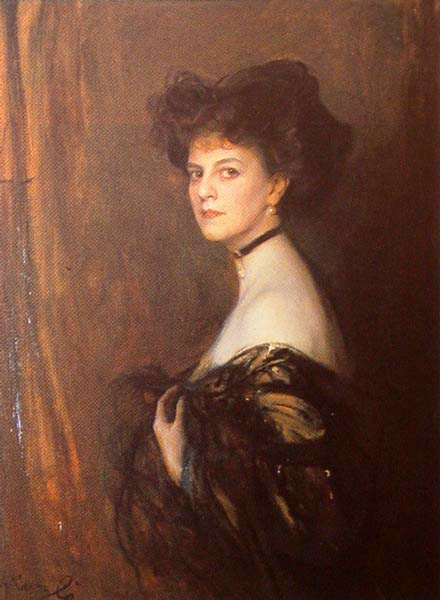
Quoted From: Alfred Stevens - Wikipedia
Additional Biographical Background from Art Renewal Center Museum
ALFRED STEVENS, (1828-1906), Belgian painter, was born in Brussels on the 11th of May 1828. His father, an old officer in the service of William I, king of the Netherlands, was passionately fond of pictures, and readily allowed his son to draw in the studio of François Navex, director of the Brussels Academy. In 1844 Stevens went to Paris and worked under the instruction of Camille Roqueplan, a friend of his father's; he also attended the classes at the École des Beaux Arts, where Ingres was then professor. In 1849 he painted at Brussels his first picture, A Soldier in Trouble, and in the same year went back to Paris, where he definitely settled, and exhibited in the Salons. He then painted Ash-Wednesday Morning, Burghers and Country People finding at Daybreak the Body of a Murdered Gentleman, An Artist in Despair, and The Love of Gold. In 1855 he exhibited at the Antwerp Salon a little picture called At Home, which showed the painter's bent towards depicting ladies of fashion. At the Great Exhibition in Paris, 1855, his contributions were remarkable, but in 1857 he returned to graceful female subjects, and his path thenceforth was clear before him. At the Great Exhibition of 1867 he was seen in a brilliant variety of works in the manner he had made his own, sending eighteen exquisite paintings; among them were the Lady in Pink (in the Brussels Gallery), Consolation, Every Good Fortune, Miss Fauvette, Ophelia, and India in Paris. At the Paris International Exhibitions of 1878 and 1889, and at the Historical Exhibition of Belgian Art, Brussels, 1880, he exhibited The Four Seasons (in the Palace at Brussels), The Parisian Sphinx, The Japanese Mask, The Japanese Robe, and The Lady-bird(Brussels Gallery). He died on the 24th of August 1906. Alfred Stevens is one of the race of great painters, wrote Camille Lemonnier, and like them he takes immense pains with the execution of his work. The example of his finished technique was salutary, not merely to his brethren in Belgium, but to many foreign painters who received encouragement from the study of his method. The brother of Alfred Stevens, Joseph Stevens, was a great painter of dogs and dog life.
See J. du Jardin, L'Arifiamand; Camille Lemonnier, Histoire des beaux arts en Belgique.
Source: Entry in the 1911 Edition Encyclopedia
Quoted From: Art Renewal Center Museum - Alfred Stevens
Various Works of Alfred Émile Léopold Stevens


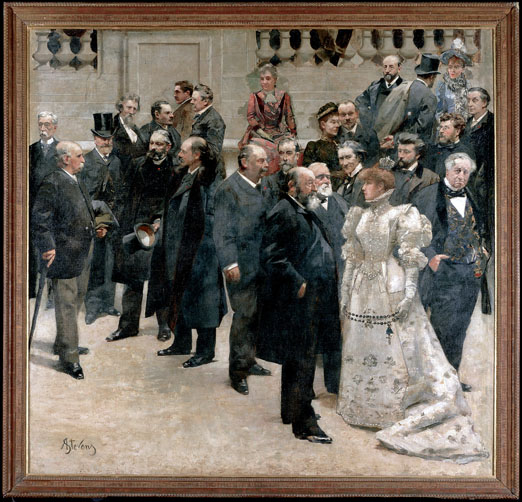
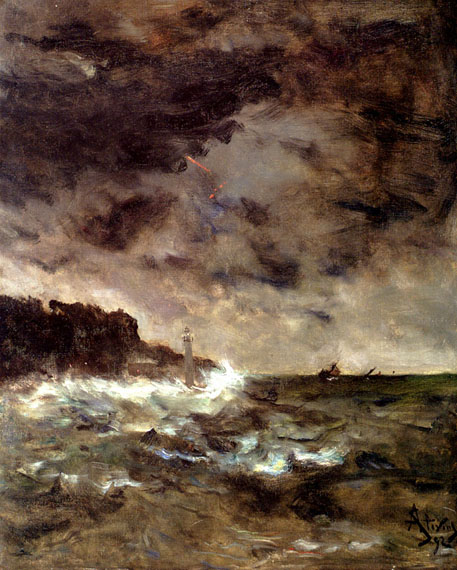
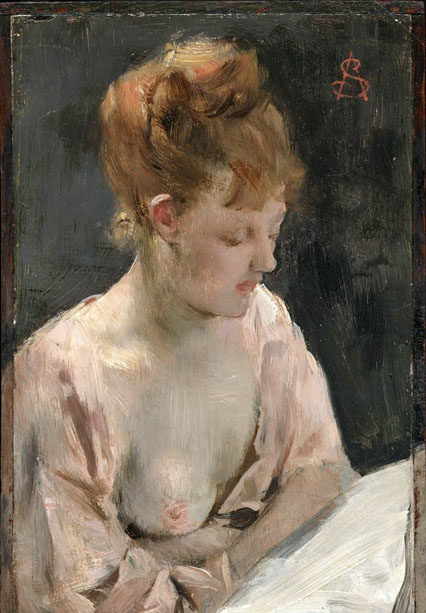
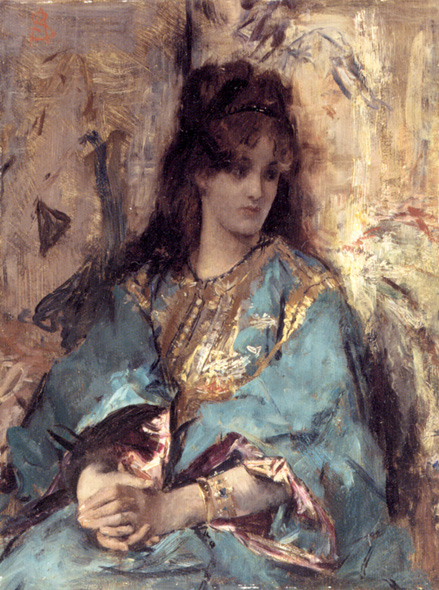
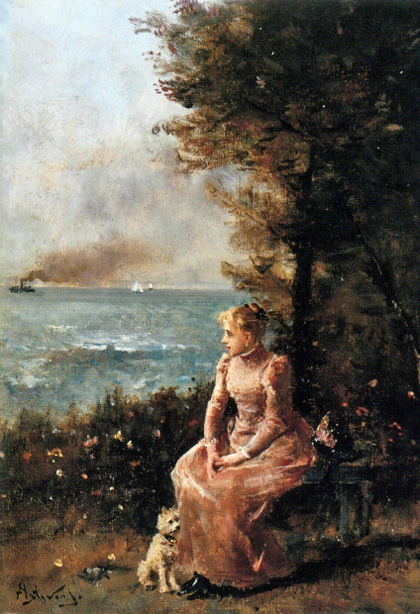
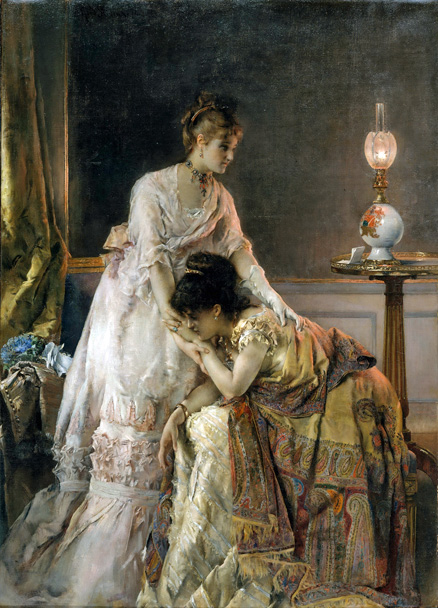
This painting, also known as "Confidence," is one of several by Stevens to treat the theme of consolation. As in his other works from the 1870s, here the anecdotal content of a letter containing distressing news asserts itself in a glimpse of the life of fashionable Parisian women in their elegant interiors. Stevens' subject matter and his meticulous attention to contemporary dress and decor elicited analogies to seventeenth-century Dutch and Flemish art; in fact, one critic called him the Gerard ter Borch of France.
Quoted From: The Metropolitan Museum of Art - After the Ball
~ Senex


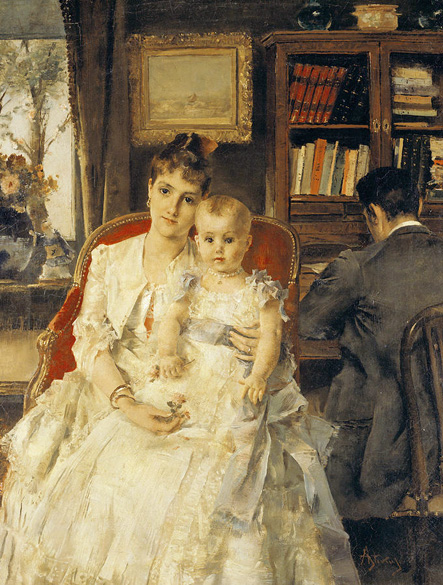
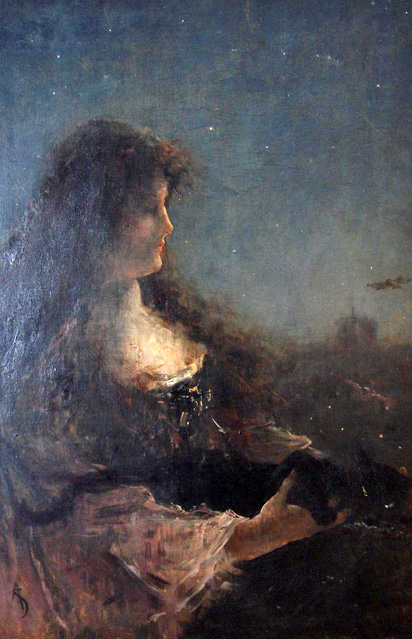
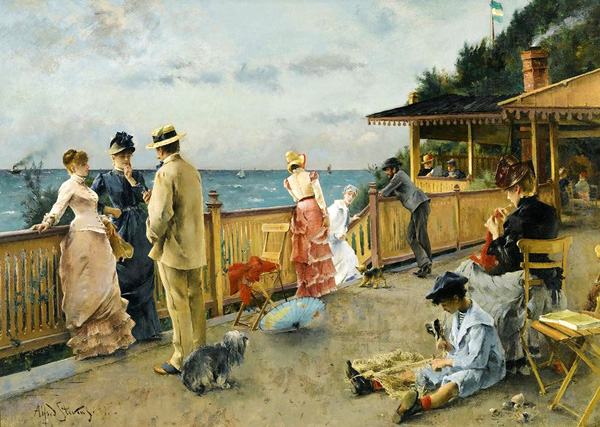
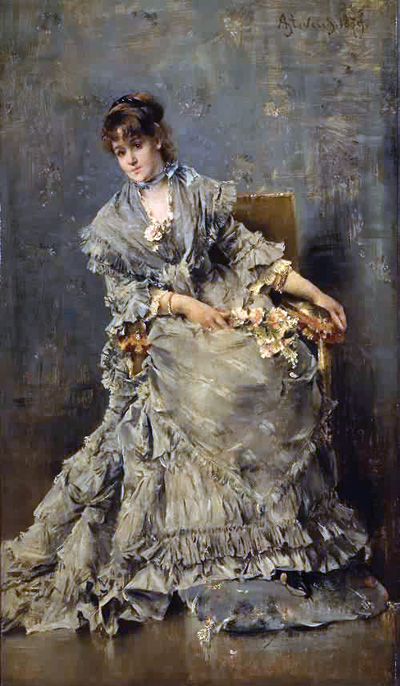
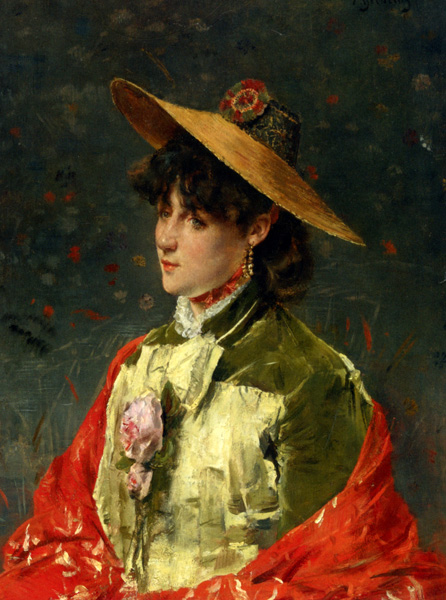
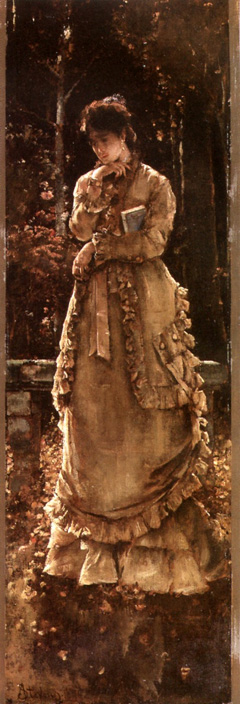
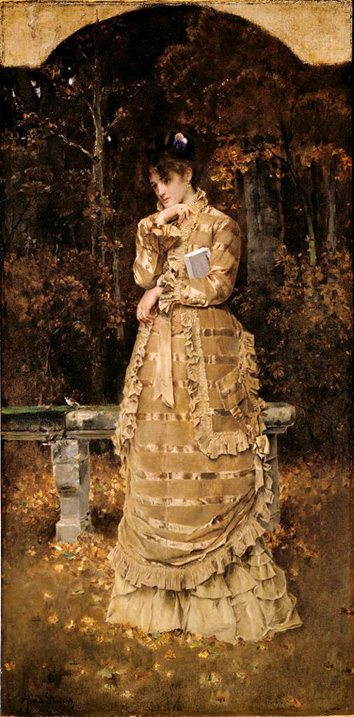
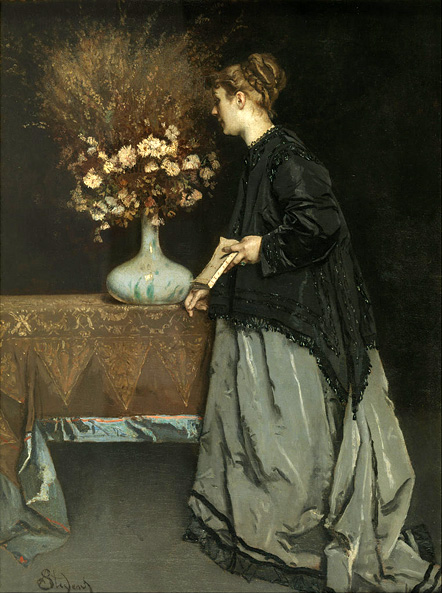
Portrait of a lady with a vase of flowers paint by the Belgian artist Alfred Stevens (1823-1906) - Brussel: Royal Museum of Fine Arts (Belgium)
Quoted From: Alfred Stevens - Art
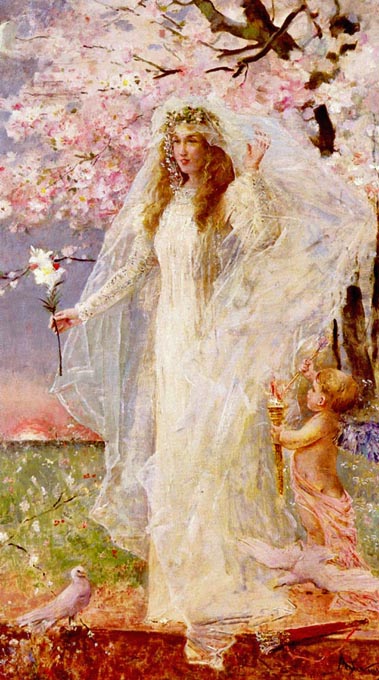
In Greek mythology, Hymen was a god of marriage ceremonies, inspiring feasts and song. Related to the god's name, a hymenaios is a genre of Greek lyric poetry sung during the procession of the bride to the groom's house in which the god is addressed, in contrast to the Epithalamium, which was sung at the nuptial threshold. The god is also sometimes called Hymenaios by metonym.
Hymen was supposed to attend every wedding. If he didn't, then the marriage would supposedly prove disastrous, so the Greeks would run about calling his name aloud. He presided over many of the weddings in Greek mythology, for all the deities and their children.
Hymen was celebrated in the ancient marriage song of unknown origin (called a Hymenaios) Hymen o Hymenae, Hymen delivered by G. Valerius Catullus. Both the term hymn and hymen are derived from this celebration.
At least since the Italian Renaissance, Hymen was generally represented in art as a young man wearing a garland of flowers and holding a burning torch in one hand.
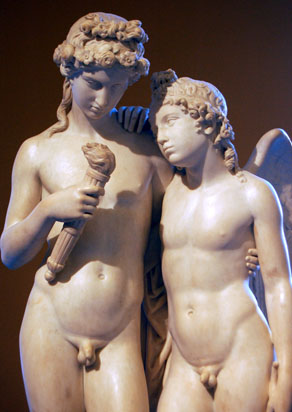
Quoted From: Hymen (Greek God) - Wikipedia
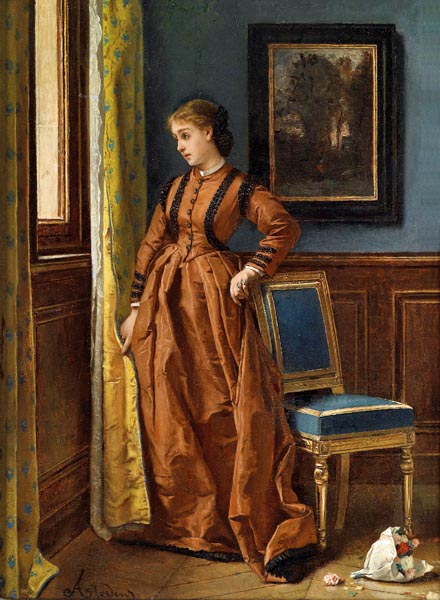

Stevens was appreciated in his day for his elegant evocations of opulent environments, fashionable dress, and refined manners, often represented by a single figure, as here, going about the rituals of genteel daily life. The title, however, with its suggestion of an amusing anecdote, was probably given to the painting only when it came to the United States in the late nineteenth century.
Quoted From: Philadelphia Museum of Art - Departing for the Promenade

Historian sniffs: "It isn't a picture. It is a painting. Oil on canvas, mounted on a parquet panel."
Writer pouts: "You know what your problem is? You are too literal. What are paintings if not pictures telling a story. Who do you think this woman was?"
Historian: "As the title indicates, she was an anonymous Victorian lady. Although, I am not entirely sure ladies engaged in billiards."
Writer: "Shows what you know. I read that in 1426 there was a Frenchwoman who could defeat all challengers."
Historian: "But was she a lady? No respectable woman would play a game exposing so many, ahem, points of interest."
Writer: "There you go again. Too literal. Women began participating in public competitions sometime after 1900. And this picture is dated 1906 or before."
Historian: "Look at the painting. Such detail on the carpet. The subject is not playing in public."
Writer: "I agree. Can you see what's behind the picture?"
Historian: "Painting."
Writer: "Whatever. Step back from facts and imagine who this woman might be. The details on her gown, the train. This is an evening entertainment. The lady is relaxed, confident. Has her eye on the ball, so to speak."
Historian: "And respectable. Notice she does not bend over too far. Look how the artist designates the placement of her legs by the flow of her dress."
Writer: "Exactly. Hmmm…who might she be playing? I think she must be in the library."
Historian: "That would be the only correct place for such a large game table. I have seen them in conservatories, but this is an interior room."
Writer: "I think she is playing with her brother. Perhaps he is home from school - perhaps a college in Oxford. Maybe he brought a few friends."
Historian: "Really! Next you'll suggest she's playing for money."
Writer: "No. She is playing to prove a point. Billiards is a game of analytical skill and manual dexterity - abilities open to both sexes. Win or lose, she has the right to play."
Historian: "You may be on to something. That could be what inspired the artist."
Writer: "Or not. That's the miracle of art. There are technical points of time, place, and skill. But, if one looks deeper, there is always a story.
Quoted From: HISTORIAN & WRITER DISCUSS A PICTURE - Blob from Sandra Wagner-Wright
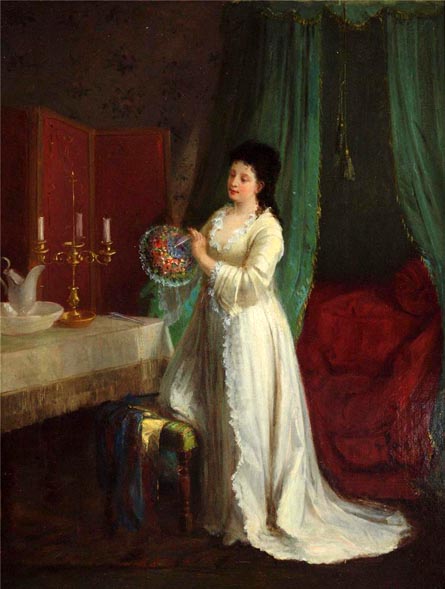
Belgian artist Alfred Stevens (1823-1906) was one of the most well-known artists in Paris in the second half of the 19th century. He caused a furor with his paintings of elegant, intriguing and distant women. The artist captured the contemporary worldly woman convincingly and deftly, paying close attention to the gorgeous textures of the clothing and luxuriously appointed interiors.
From 1862 onwards Stevens' works feature more and more exotic elements. He and painter James McNeill Whistler were among the first artists to cultivate a fascination with Japanese art and objects. Stevens was also an eclectic collector, filling his house with furniture and works of art from a wide range of periods, styles and countries. Still, he was primarily interested in attractive exotic trinkets and items such as kimonos, fans, parasols and folding screens, which he incorporated in his paintings.
Stevens not only painted the Parisian bourgeoisie; he was also an active participant in the decadent life of Parisian society. His close friends included luminaries of the French literary and artistic circles, from authors Charles Baudelaire and Alexandre Dumas Jr. to painters Édouard Manet and Edgar Degas, and actress Sarah Bernhardt.
Quoted From: Van Gogh Museum - Alfred Stevens
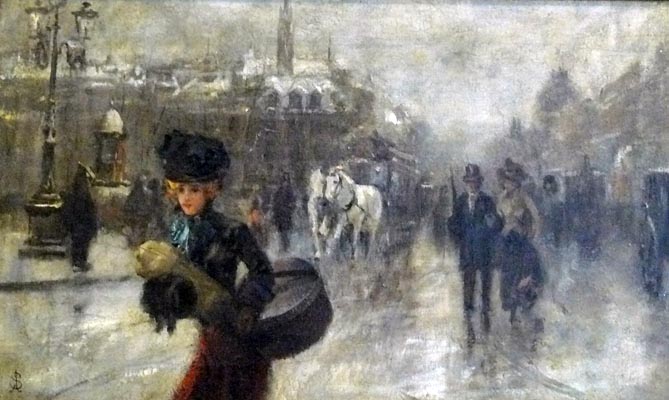
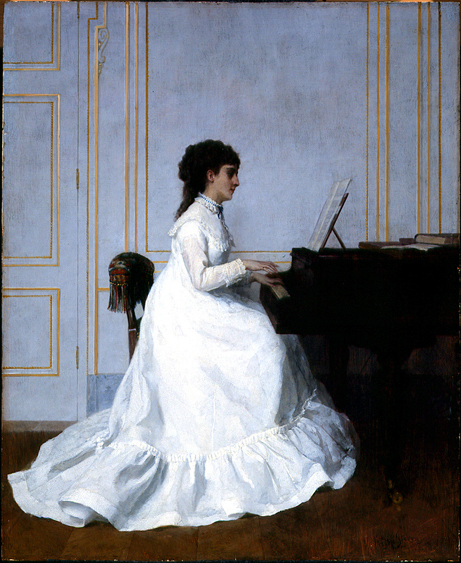
Eva Gonzalez was the daughter of the novelist Emmanuel Gonzalez, a Frenchman of Spanish descent. She was taught by Charles Chaplin who was also Mary Cassatt's teacher. She met Manet in 1869, and was to become his student, colleague and model. Most historians believe that women painters working in France at the end of the 19th-century created works that were as innovative as those of their male counterparts; but that they were marginalized because of the prejudice of the strict social rules for their gender.

As they began painting in the last quarter of the 19th-century, Berthe Morisot (1841-1895), Mary Cassatt (1844-1926), Eva Gonzalès (1849-1883), & Marie Bracquemond (1840-1916) were subjected to critical ambivalence & lacked major public exhibitions.
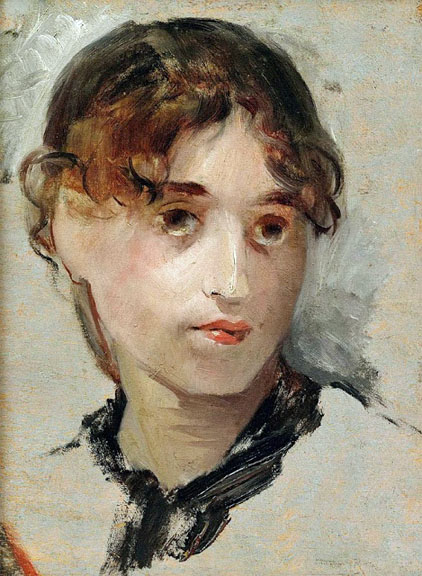
An upper-class woman living in Paris in the late 19th century was subject to a strict code of social conduct. An unmarried woman could not leave her home without a chaperone, nor could she frequent a café or the theater by herself without risk to her reputation.
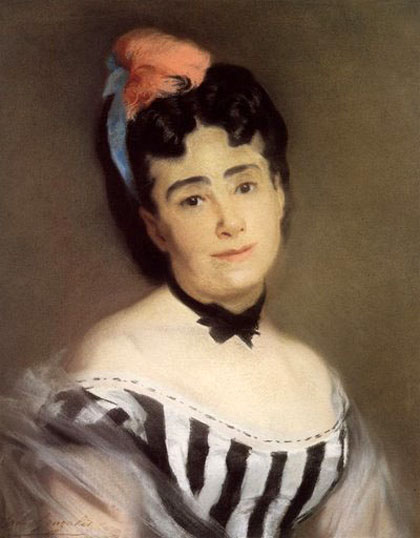
These women were meant to know their place, which was not to compete in the man's world. As a result, women were encouraged to develop interests in the decorative arts, music, and painting. These less serious pursuits would be practiced in the company of other women. Learning these arts was meant to refine a lady's taste rather than train her for a career. And the art of these women could not, then, threaten their male counterparts.
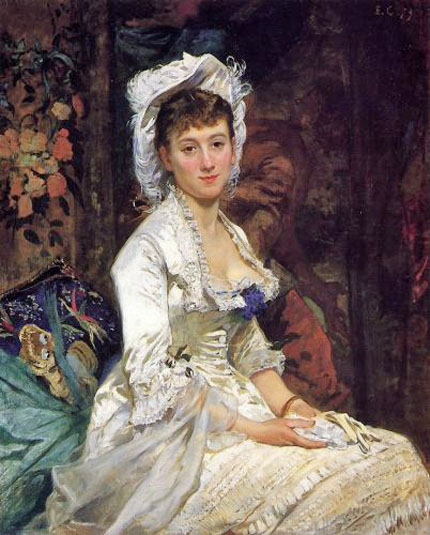
As they shaped their unique careers and artistic styles, Morisot, Cassatt, Gonzalès, and Bracquemond negotiated not only the personal challenges of everyday life but also those dictated by the conventional ideas of acceptable behavior for women at the time.

In 1874, the group of artists known as the Impressionists, whose painting style featured quick, visible brush strokes, bold colors, and an emphasis on the play of natural light, mounted the 1st of 8 privately organized exhibitions.
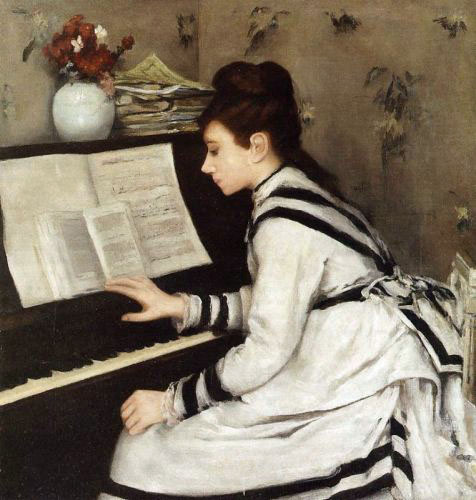
Compared to previous painting movements of the 19th-century where canvases were large and themes were heroic, historical or religious, the Impressionist style encouraged smaller paintings which were easier to transport & often painted outdoors. Women did not need to be in a formal class to capture the popular Impressionist subjects of family, children, or friends and landscapes of the nearby garden or countryside.
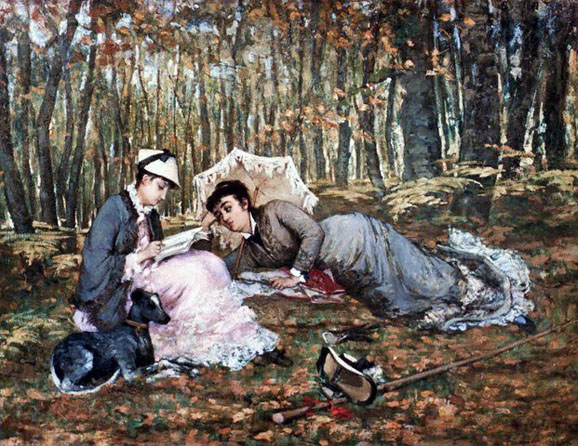
Because of her family access to the Impressionists, Berthe Morisot was the only woman to exhibit in the 1st Impressionist exhibition, and continued to show in the next 7 of the 8 Impressionist exhibitions. Married to the brother of Manet & close friends with Renoir, Morisot became one of the most prolific members of the Impressionist circle.
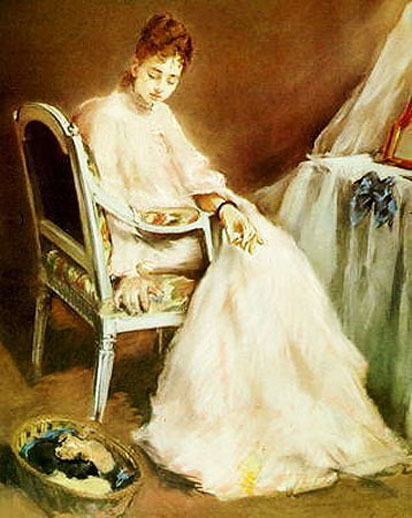
Pennsylvania-born Mary Cassatt was the only American in the Impressionist circle. After studying painting in Philadelphia and throughout Europe, she settled permanently in Paris in 1875. She became close friends with Degas and exhibited in 4 of the Impressionist exhibitions. While Cassatt personally rejected the norms of marriage and motherhood, she professionally adopted exactly those themes, painting women as "Subjects, not objects."
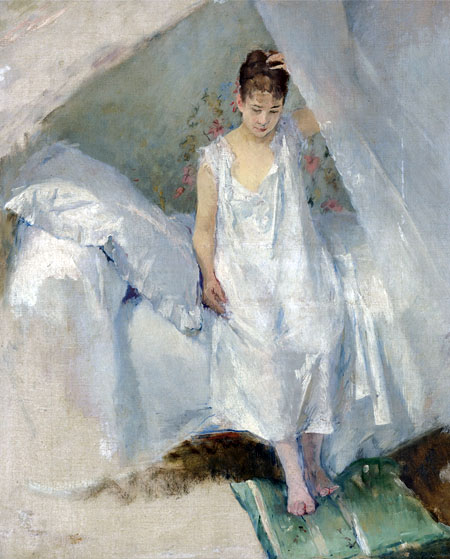
Gonzalès was Manet's only student and modeled frequently for several members of the Impressionist school. It was unthinkable at the time for a young girl of good family to attend the atelier of Edouard Manet, who had shaken the Establishment with his painting Olympia, exhibited at the Salon of 1863. With this work, rejected at the time, the artist opened the way for the Impressionists and became the precursor of modern art. Yet Eva became his student, his only pupil, in February 1869. Until 1872, she was strongly influenced by Manet but later developed her own, more personal style. Her work was exhibited at the offices of the art review L'Art in 1882 and at the Galerie Georges Petit in 1883. In 1879, Gonzalès married the engraver Henri Guérard. The unfinished painting Donkey Ride features her husband and her sister. Her career was cut short when she died in childbirth at the age of thirty-four, six days after the death of her teacher, Manet. Although Eva Gonzalès' died while still young in childbirth, she became known for her characteristic style for portraiture. Manet chose Gonzalès as his only formal pupil. Like her teacher, she never exhibited with the Impressionists but was considered a member of their circle. Gonzales died just months after Manet's death.
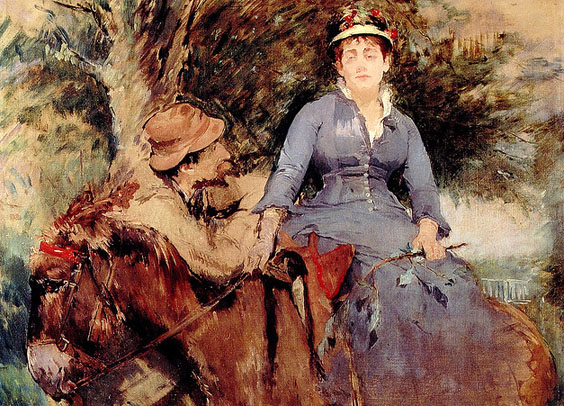
Marie Bracquemond's career fell victim to her envious husband, the less-talented artist Felix Bracquemond. Unlike the other women, Bracquemond was not wealthy and was largely self-taught. She became acquainted with Degas, Renoir, and Monet, after her designs for porcelain attracted Degas' attention. Bracquemond exhibited in 3 of the Impressionist exhibitions, before her husband's jealousy drove her to stop painting by 1890.
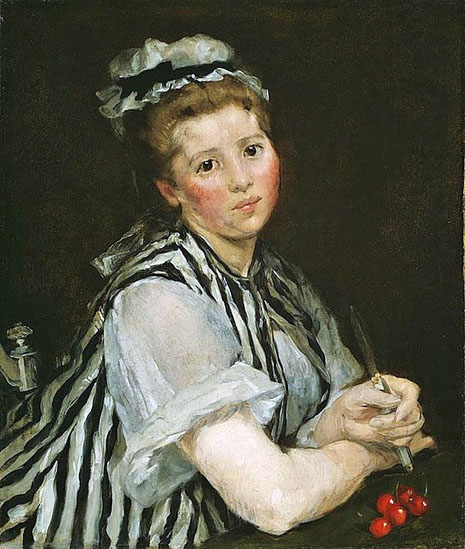
These women artists painted other females not as sexual objects, but as individuals. Reclining women, usually portrayed by male artists nude, sexual, and provocative, received honorable portrayals from female artists. Eva Gonzales' portrait of her sister Jeanne in Morning Awakening depicts her fully clothed, staring off into space, as if she just woke up. She is in her own bed with no sexual connotation to her pose. Gonzalès was challenging the age old motive for painting reclining women.

Quoted From: It's About Time: Eva Gonzalès (1849-1883) and Female Impressionists in Paris
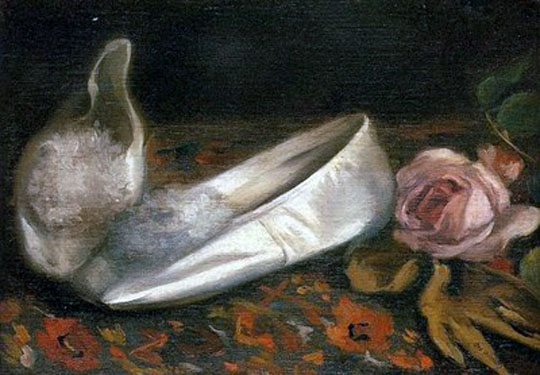
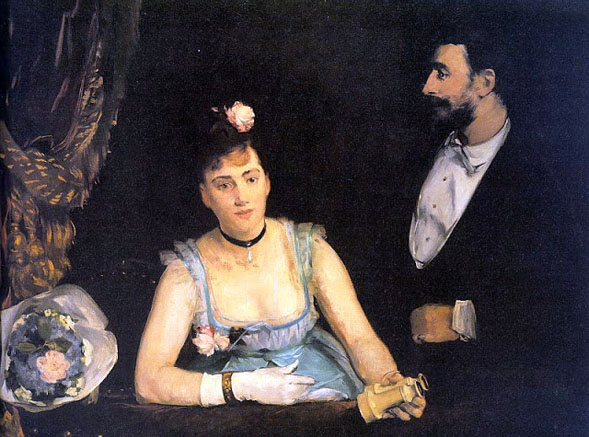
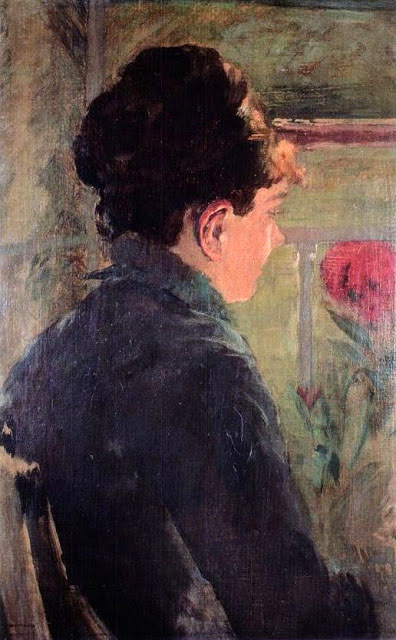
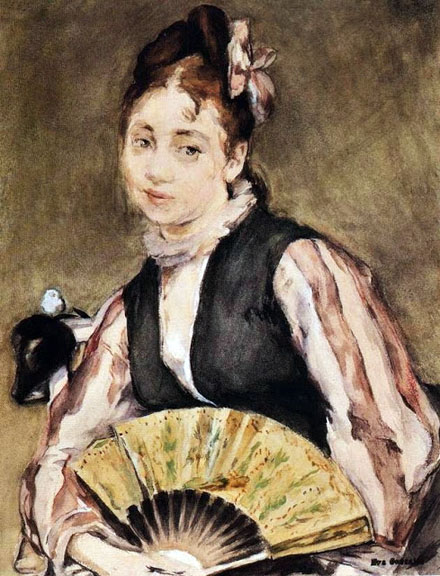
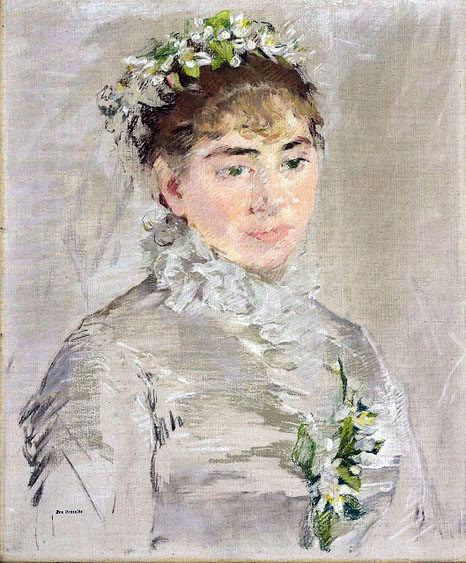
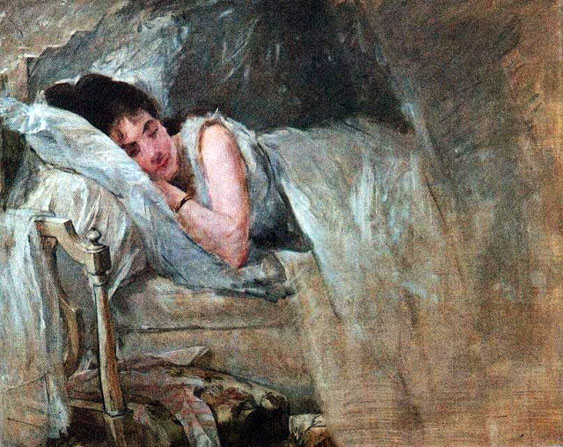

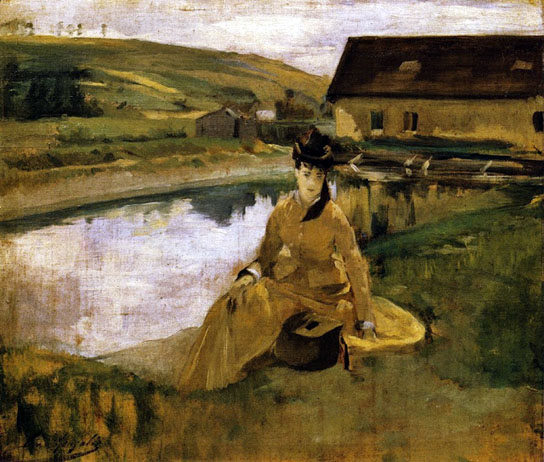

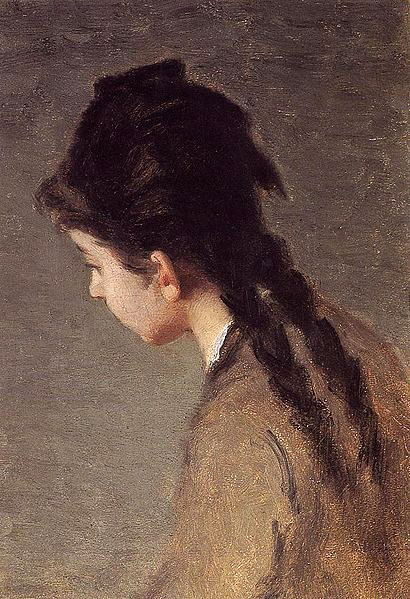
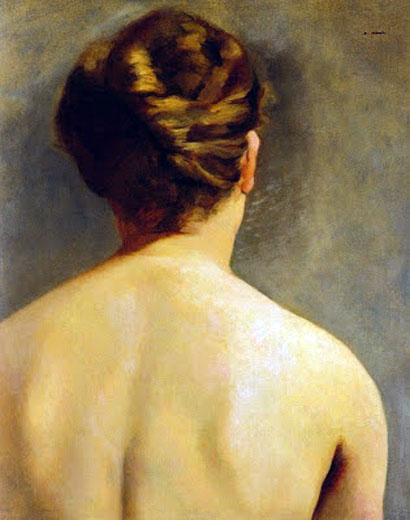
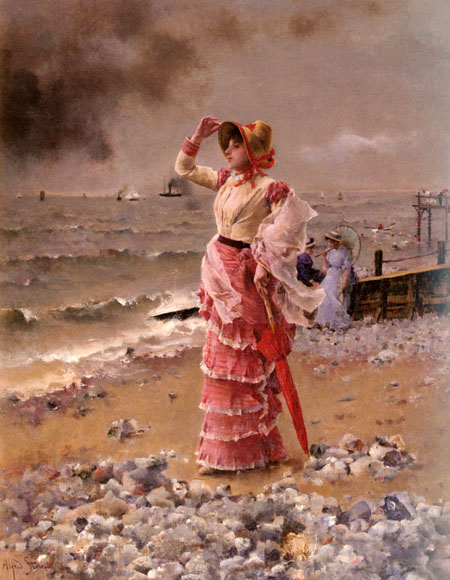
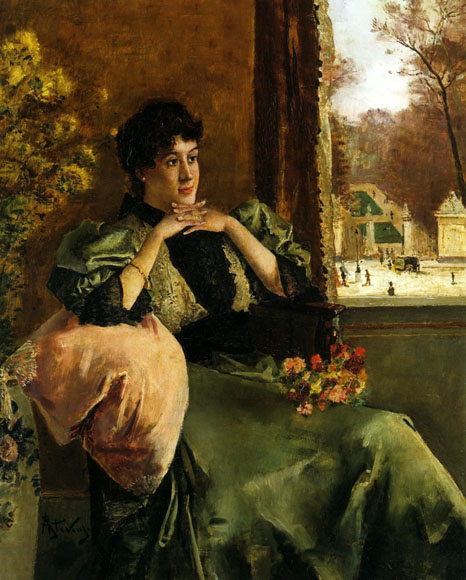
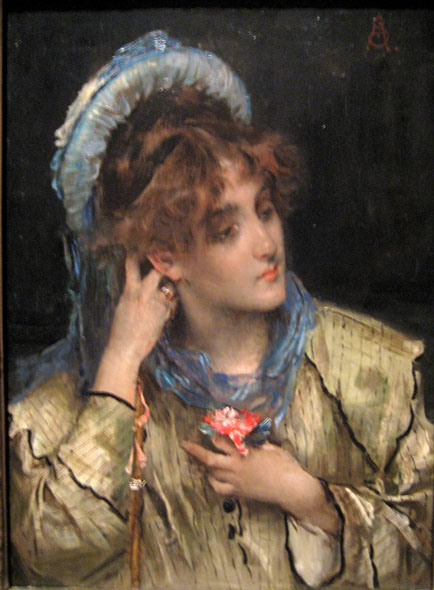

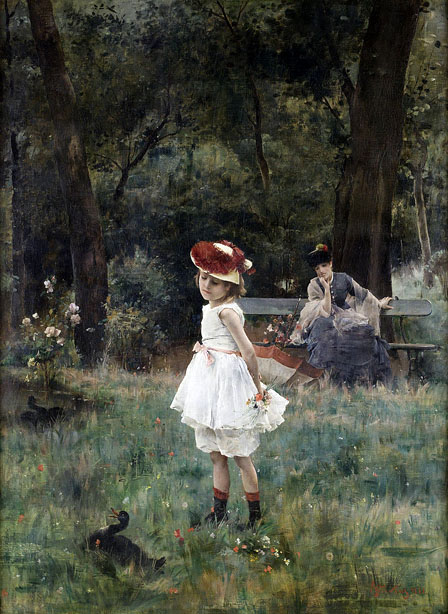

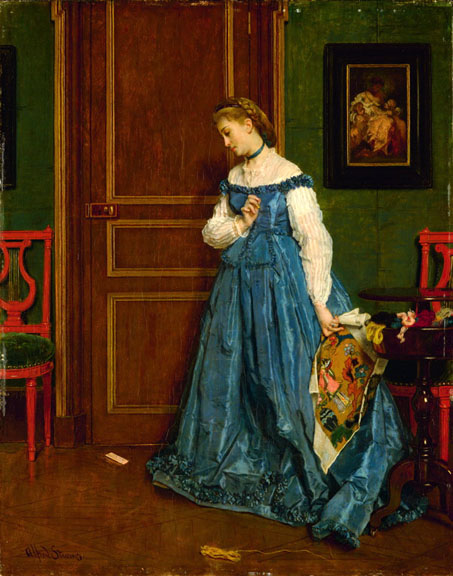

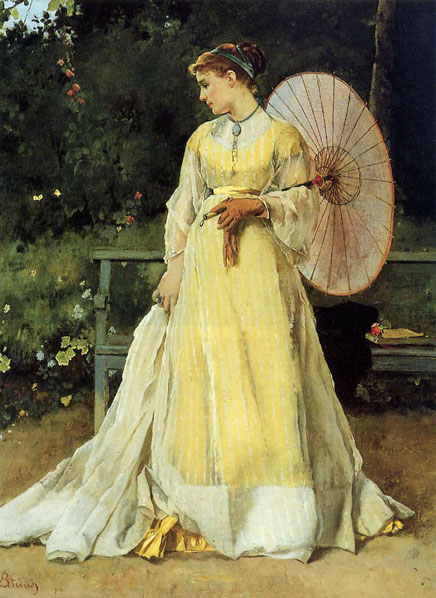
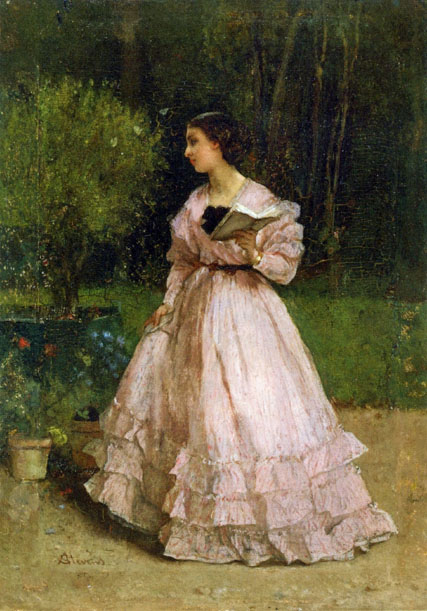
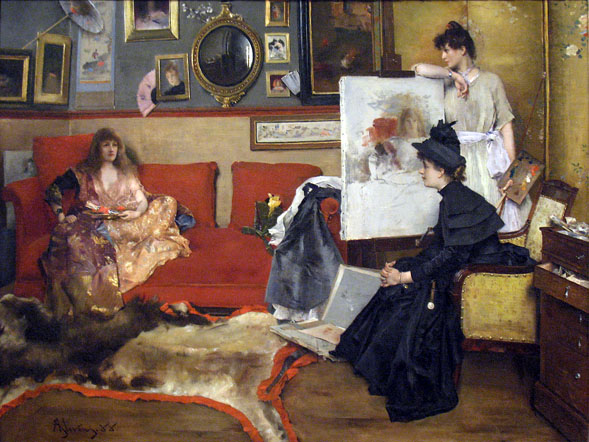
A female artist and her model take a break from a painting session to welcome a visitor to the studio. On the easel is Stevens' version of "Salomé," which is based on Regnault's famous painting of 1870 (hanging nearby). The setting is thought to be Stevens' studio, which was admired for its stylish arrangement of the exotic and luxurious objects that he collected. With the open portfolio, picture-within-the-picture, and mirror (reflecting a mundane coal stove), this work presents an elaborate play on the relationship between art and reality.
Quoted From: The Metropolitan Museum of Art - In the Studio
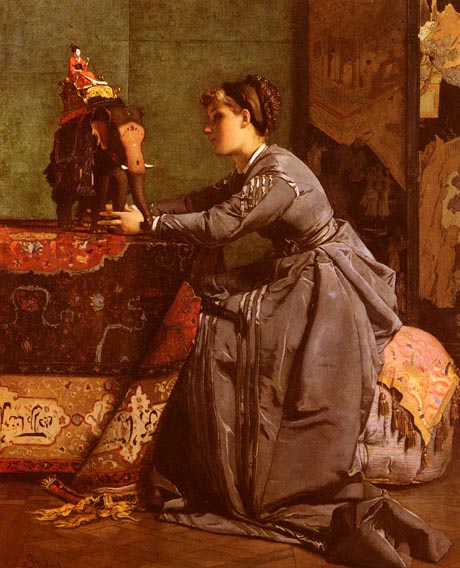
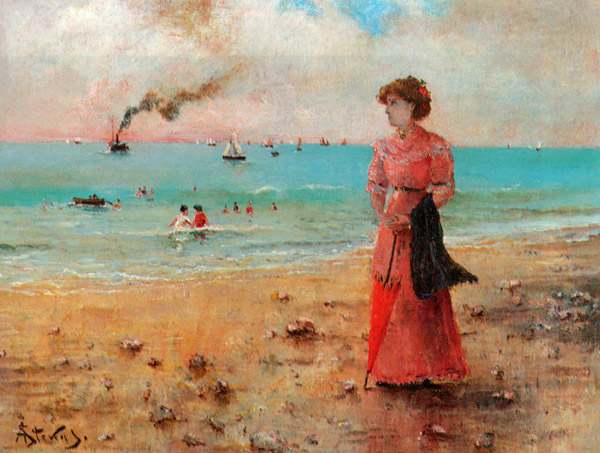
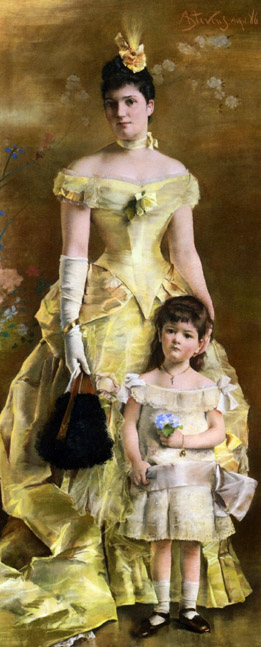
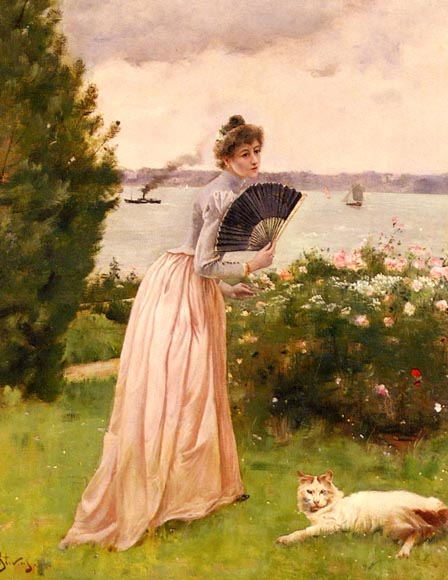
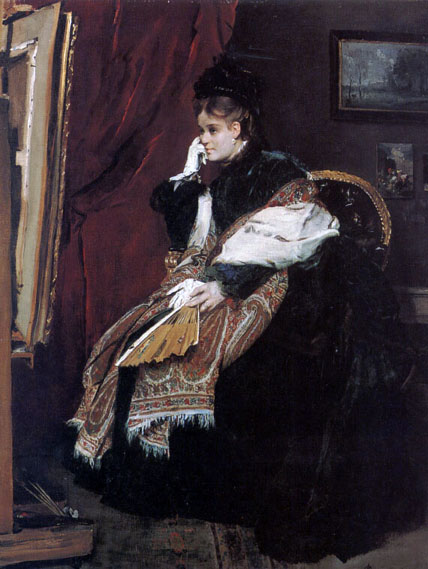
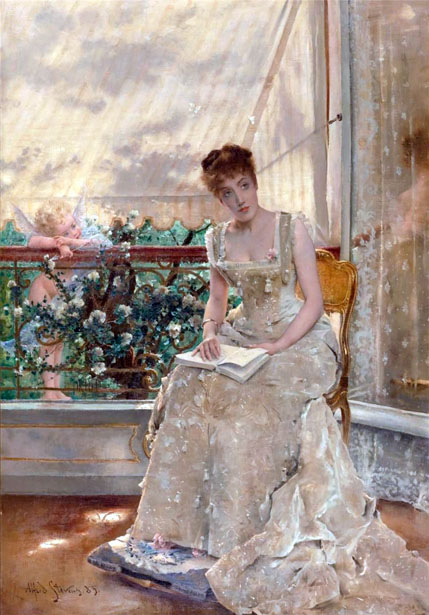
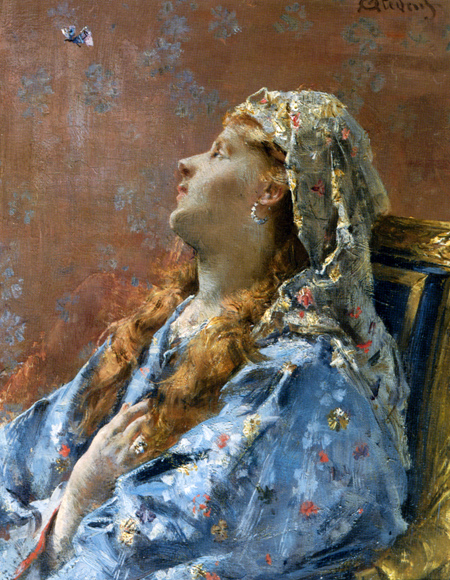
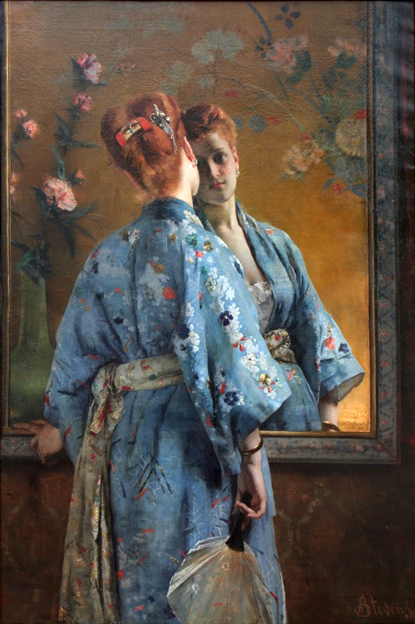
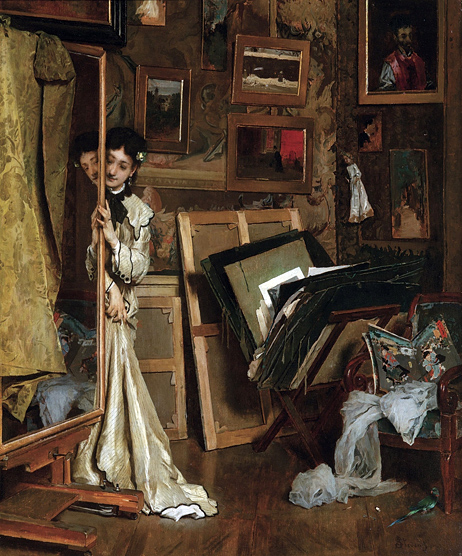
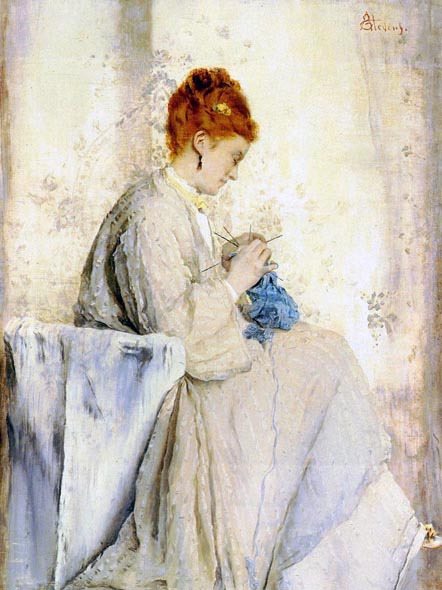

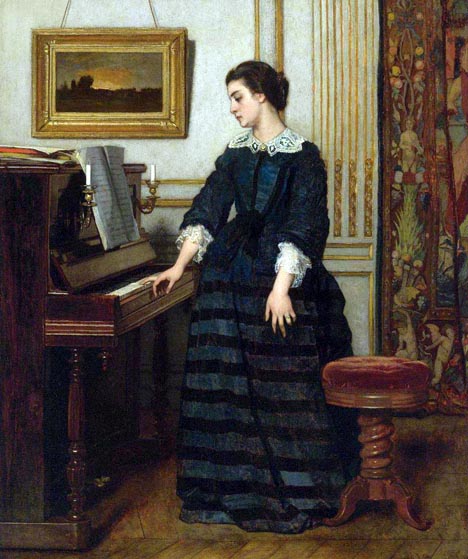
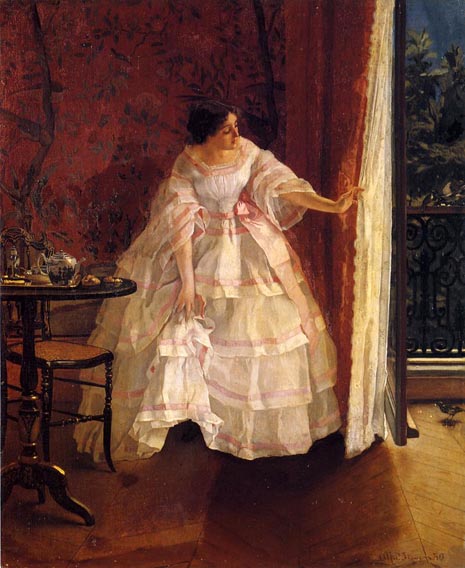

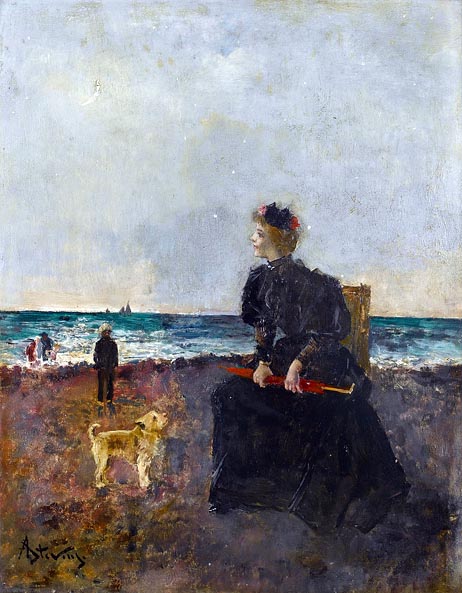
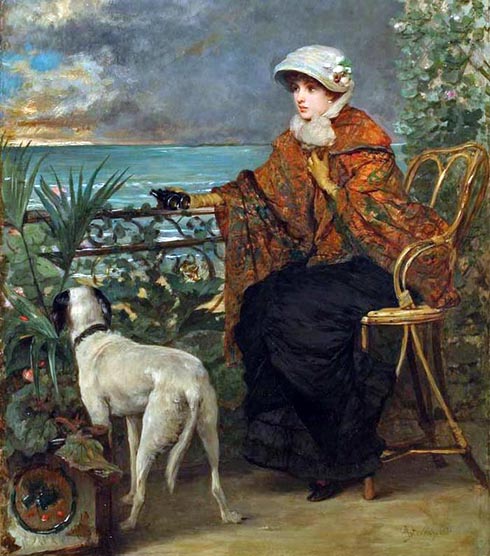
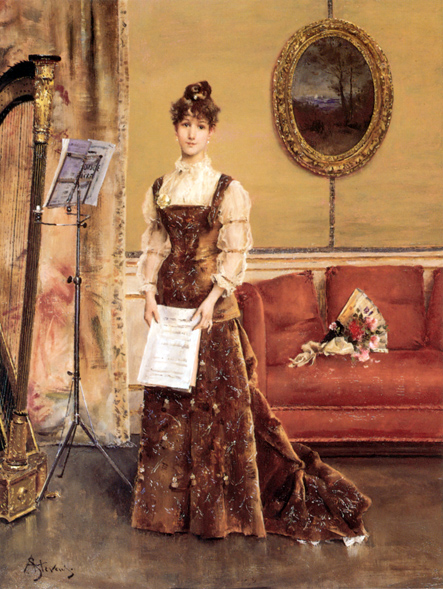
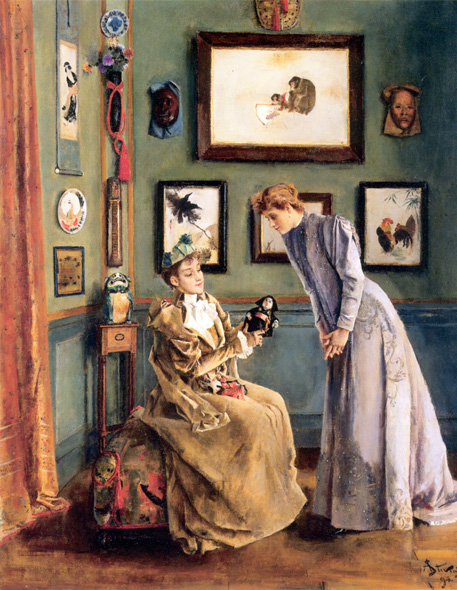
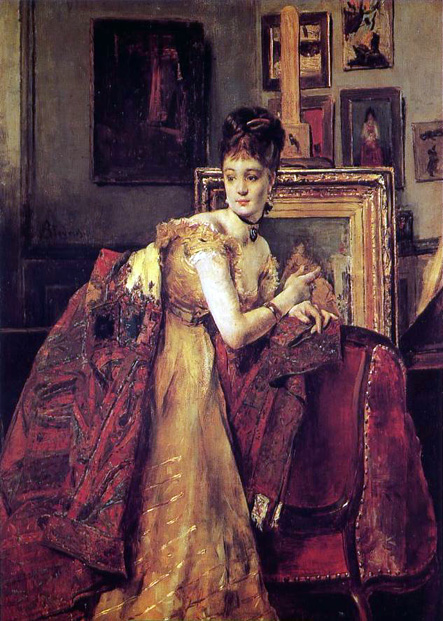
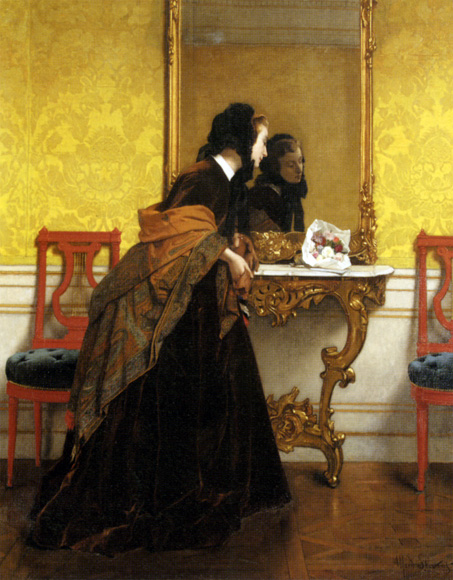
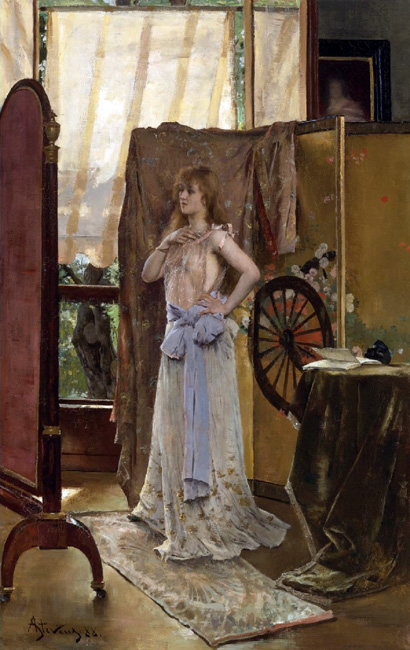
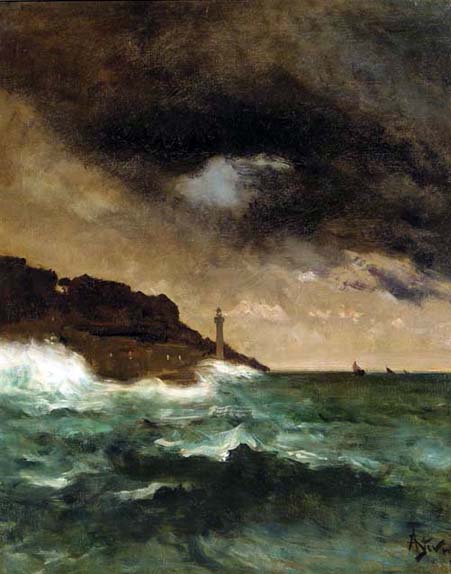


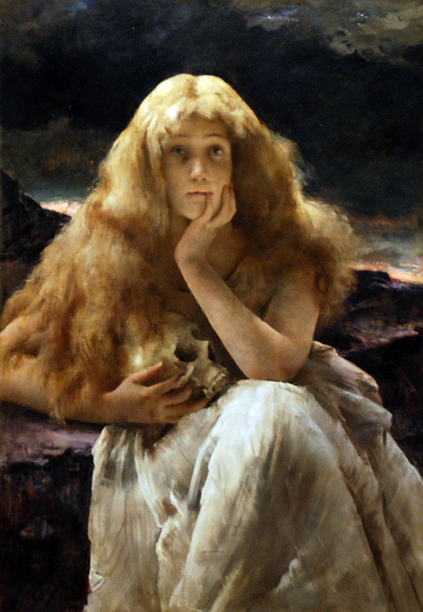
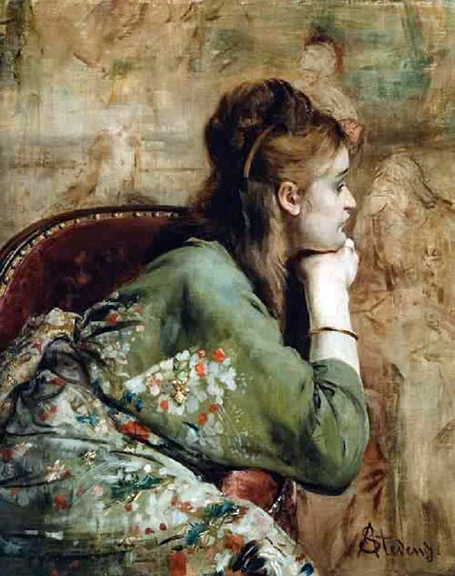
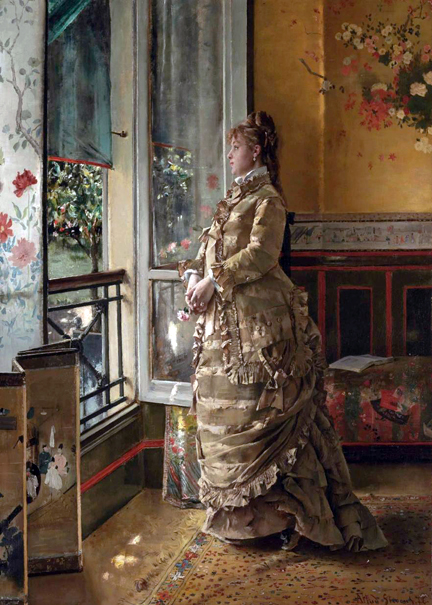

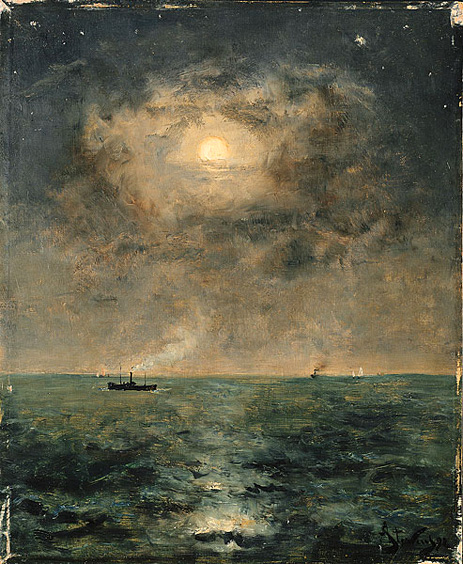
In 1880 Stevens was advised to take the sea air as a remedy for a bronchial condition allegedly caused by breathing turpentine fumes. Acting on this advice he began spending two months of each year on the Normandy coast. During these visits he painted seascapes and the hotel society of the seaside resorts. By this time his reputation was such that the dealer Georges Petit guaranteed to pay the artist 50 000 francs for his output of seascapes per season.
The exact location of the scene in the Australian National Gallery's painting remains unknown. The seascapes exhibited by Stevens at the Salon de Mar in 1892 were painted in the Le Havre-Honfleur area of Normandy, at the mouth of the Seine, while those exhibited in May 1893 were painted at Loctudy, in the west of Brittany. The inclusion of a steamer in the Gallery's painting indicates that the more populous Normandy coast is the likely location.
Stevens' depiction of the sea by moonlight evokes the tradition of seventeenth-century Dutch and Flemish nocturnal landscapes and the moonlit seascapes of Joseph Vernet (1758-1836) which were then on view in the Louvre. Stevens himself owned a 'clair de lune' by Aert van der Neer (1603/4-77), as did his friend Edouard Manet (1832-83), whose own painting of a nocturnal seascape, Moonlight over Boulogne Harbour 1869 (Musée d'Orsay, Paris), was in Stevens' studio when it was purchased by the dealer Paul Durand-Ruel in 1872.
Quoted From: Moonlit Seascape - Australian National Gallery
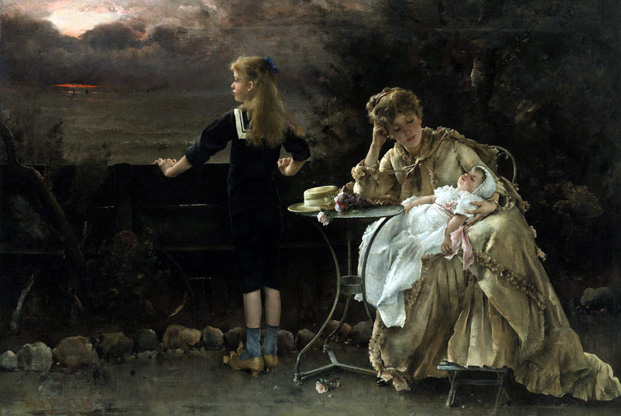
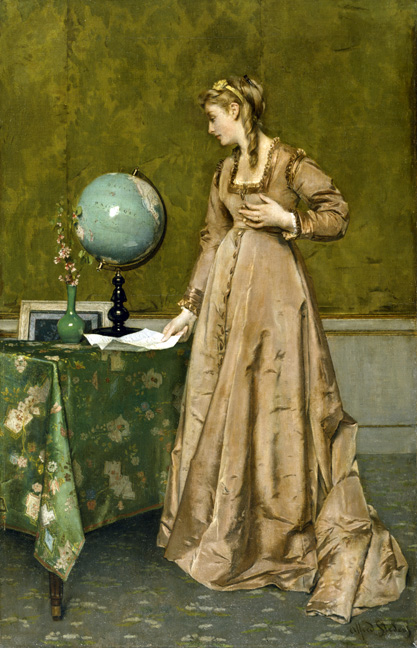
Stevens depicted domestic interiors, in which he meticulously recorded the latest fashions in dress and furnishings. Here, a young woman, who has apparently just received news from a loved one far away, clutches at her heart.
Quoted From: News from Afar - The Walters Art Museum
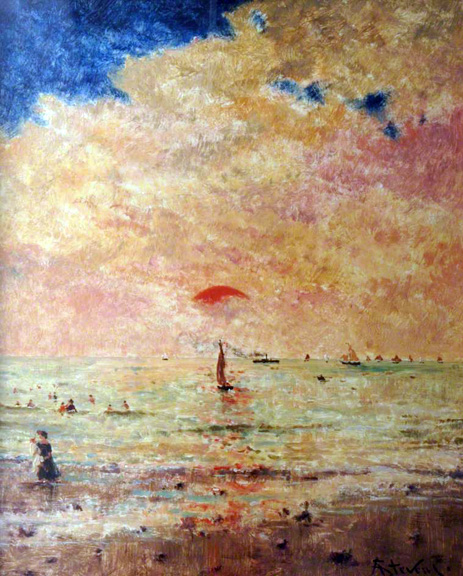
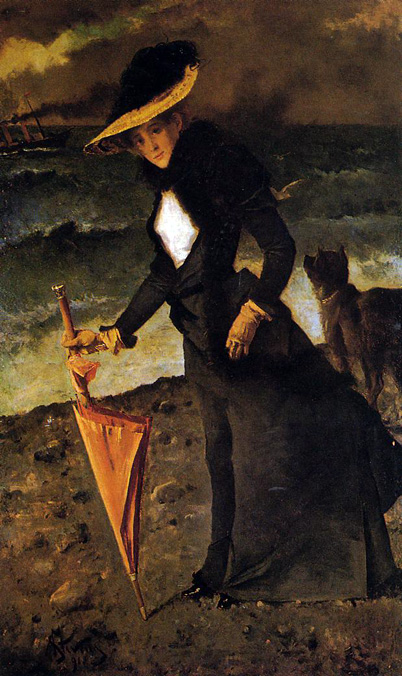

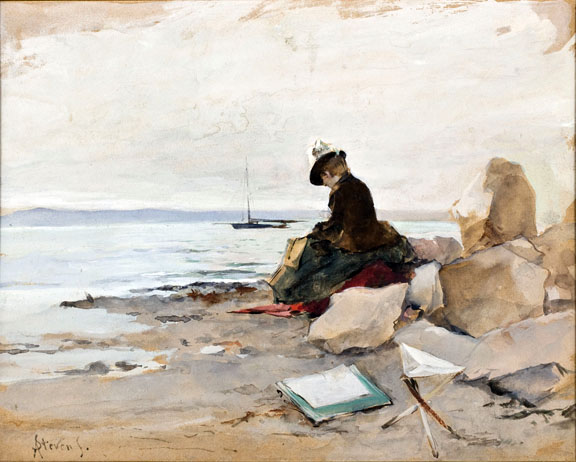

An elegantly dressed young lady is placing a sprig of box behind the frame of her mother's portrait hanging on the bedroom wall. Another bough, lying on her cloak, is intended for the adjacent miniature, presumably a portrait of her father. This picture is a variant of the more elaborate "Les amours éternelles," formerly in the collection of Robert Hoe, Sr., of New York. In the Hoe painting, a dark rather than fair-haired model, still wearing her cloak, throws a kiss in the direction of her mother's portrait while placing the greenery above it. The Hoe picture also differs in the addition of a Persian cat arching its back in the foreground.
Quoted From: Palm Sunday - The Walters Art Museum


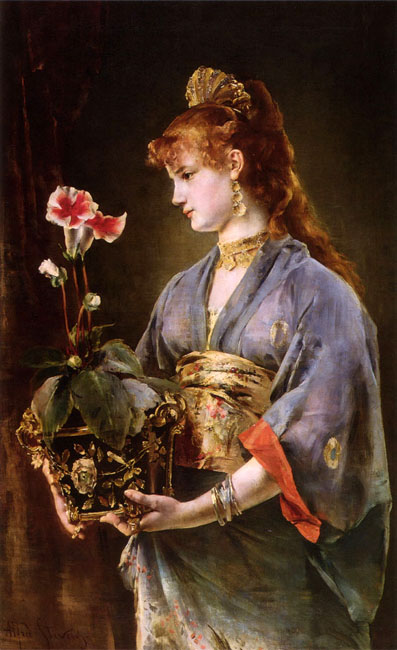
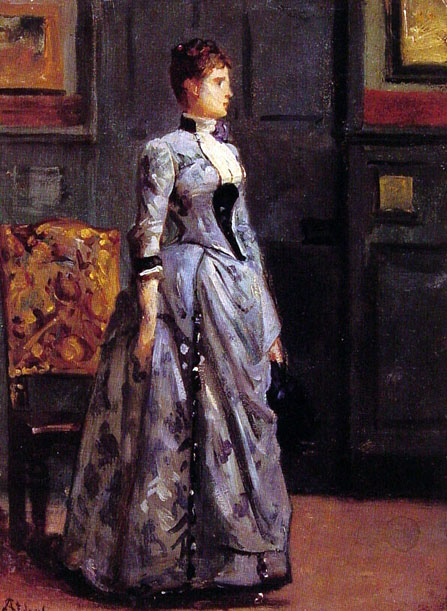
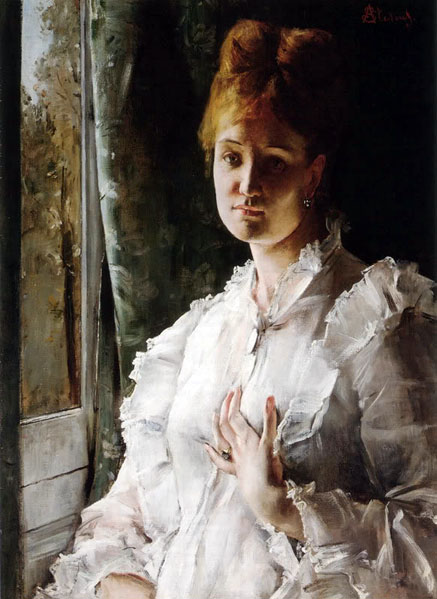
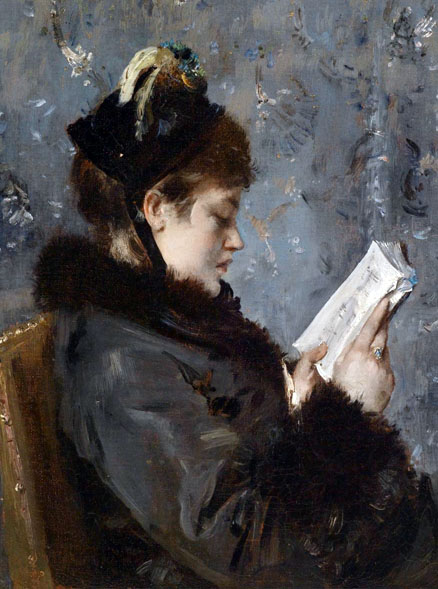
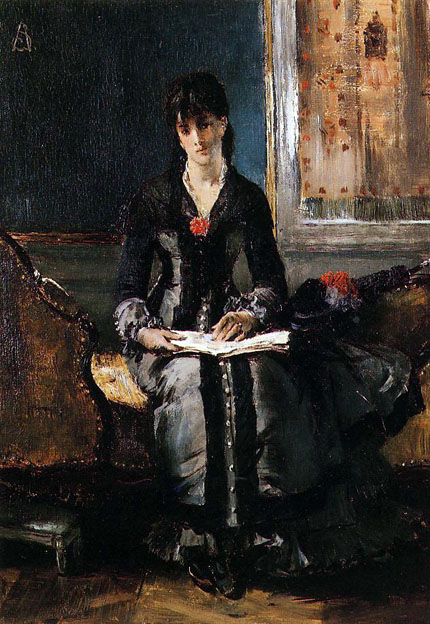
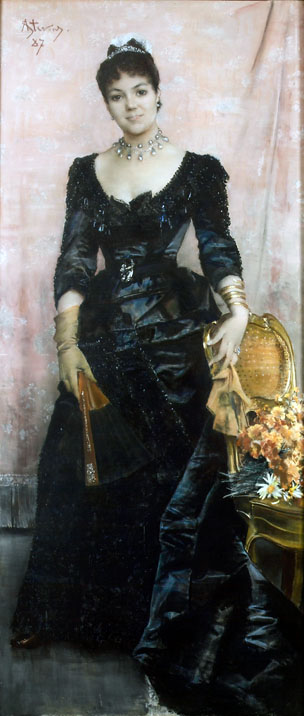
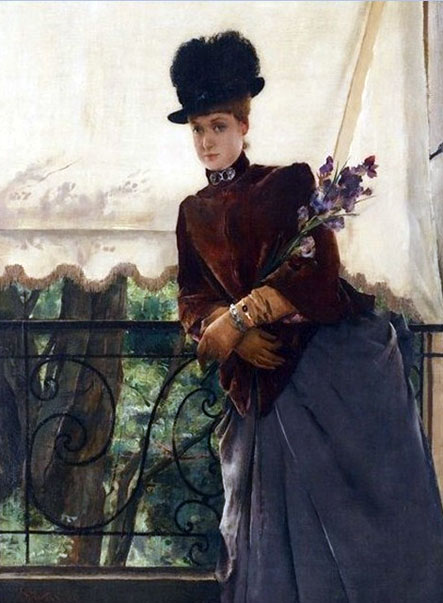
Alfred Stevens built his reputation based on paintings of sumptuously attired, anonymous beauties who were representative of a type-la belle Parisienne. The Portrait of Mademoiselle Dubois, in contrast, is a bold statement built upon direct observation of one of his students with whom he was well acquainted. Her appraising and direct gaze, as well as her relaxed posture and confident demeanor, is a daring concoction and testifies to the artist's appreciation of her intelligence and character. These qualities are thrown into high relief by the stark expanse of awning behind her. Stevens' use of such a bold foil is an innovative touch of modernity that parallels those of his close friend, Edouard Manet. The compressed space also betrays Stevens' interest in Japanese spatial construction-a reminder that he was one of the first artists in Paris (along with Manet) to collect Japanese prints and objects.
Quoted From: Portrait of Mademoiselle Dubois
_1900.jpg)
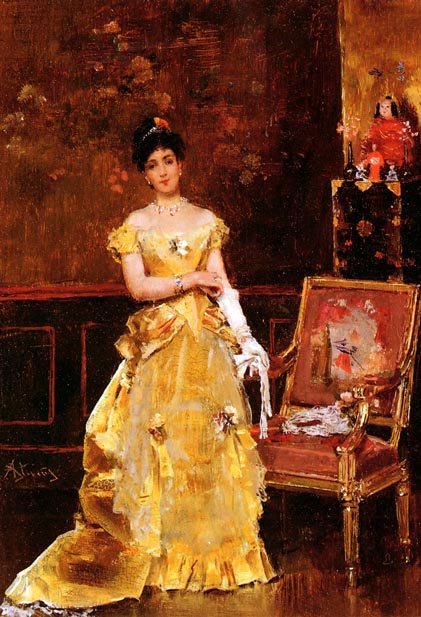
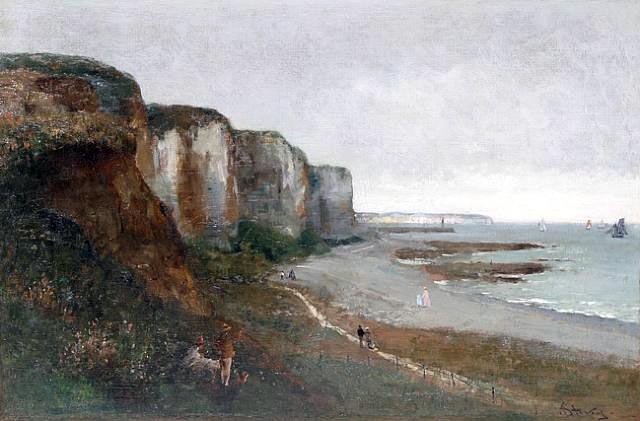
An original and detailed narrative scene with an unusual perspective of the often depicted cliffs of Normandy, the painting is a nice depiction of people at leisure. The title literally translates to "walk with the foot of a cliff in Normandy". The double entendres of walk and foot apply to both the elegant figures and the physical location's attributes, so we'll leave the definition to speak for itself, as the artwork does so well.
Much in keeping with his contemporary artists around the French coasts, a grey somber sky is flush with cool depth, and every beach visitor is properly, fully attired. Canes and parasols in hand, they stroll with children or their beloved pets. The foremost couple relaxes to watch the cutter yacht and several more sailing ships beyond the light-marked stone jetty breakwater. A lone figure prepares a bonfire stack on the beach as well.
Stevens' treatment of the different textures of the beach, ocean, chalky cliffs and lush grasses is beautiful to observe in its intended full composition and interesting close-up to the surface. While it's an impressionistic painting with loose boundaries, he gave a great deal of care to the placement of each touch of the brush. Specifically, even though there are few in the overall composition, his soft, suggestive treatment of the small wild flowers near the couple have the haphazard yet well thought out positioning true to nature. His sky has aggressive, wispy brushstrokes, and the wet sand is slick, applied in smooth layers in some spots with a stroke of a palette knife. This is a well-executed painting with desirable subjects.
Quoted From: Maritime Paintings and Art - Promenade Au Pied D'une
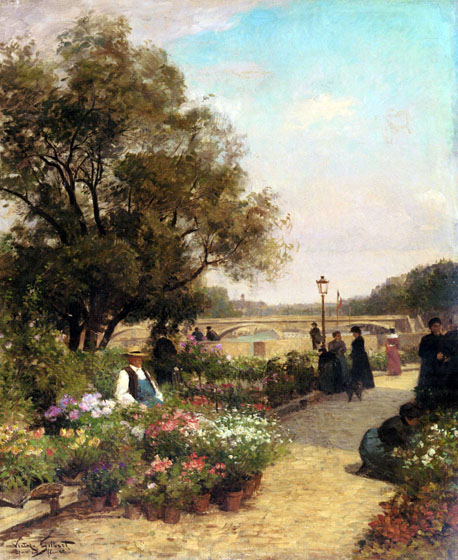
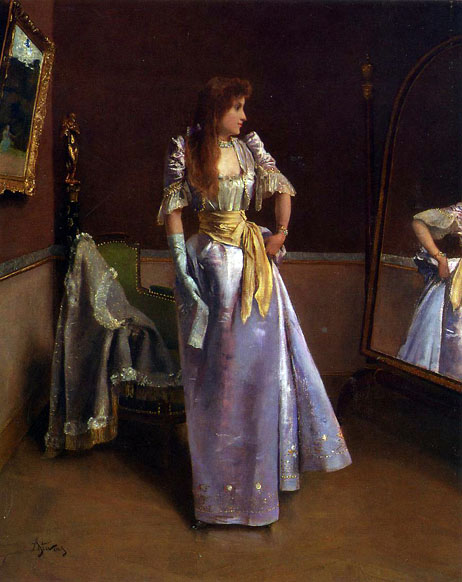
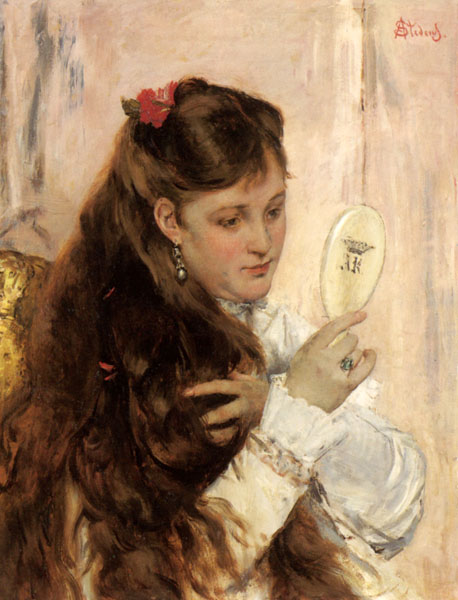
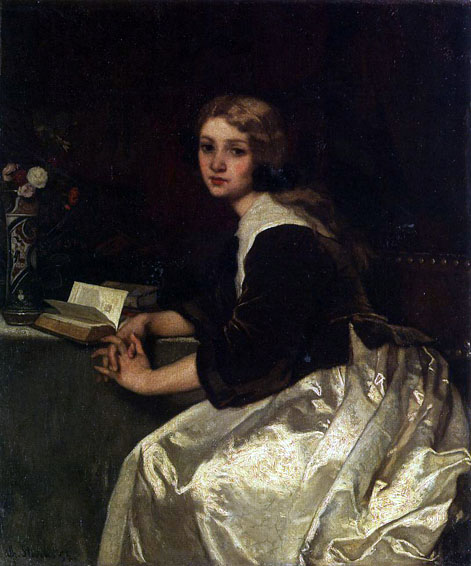
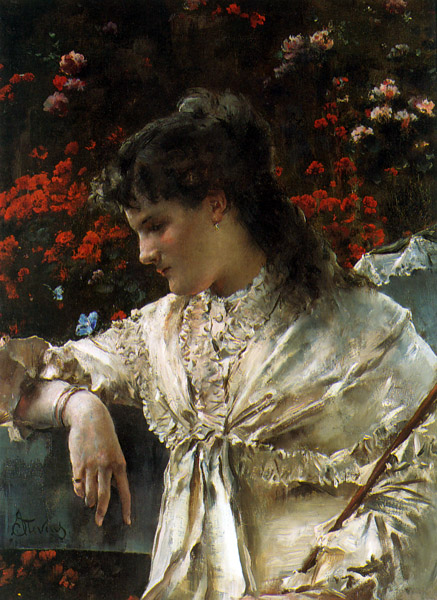
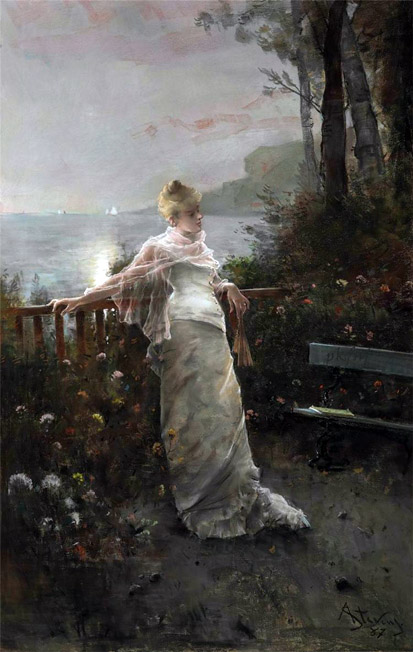
Quoted From: Reverie - Easy to understand definition of reverie by Your Dictionary
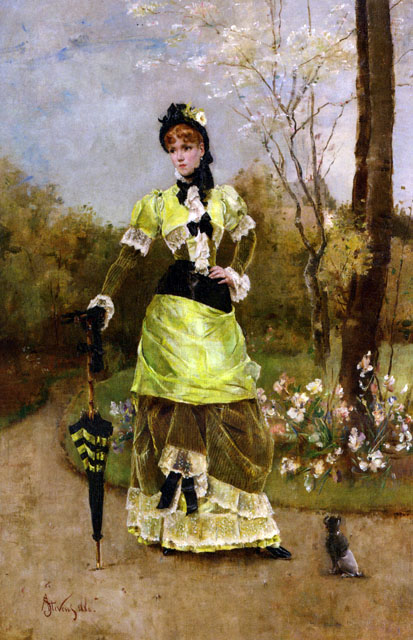
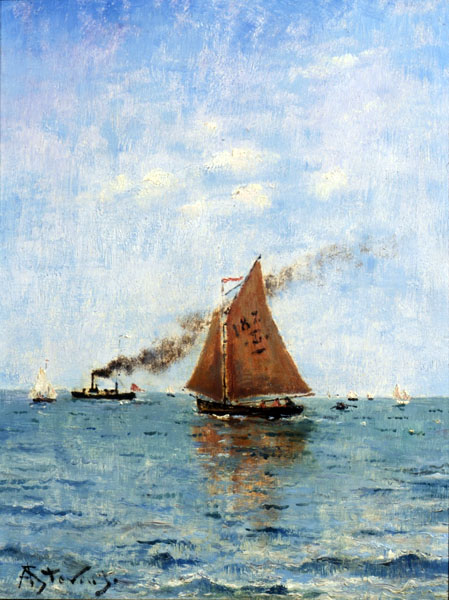


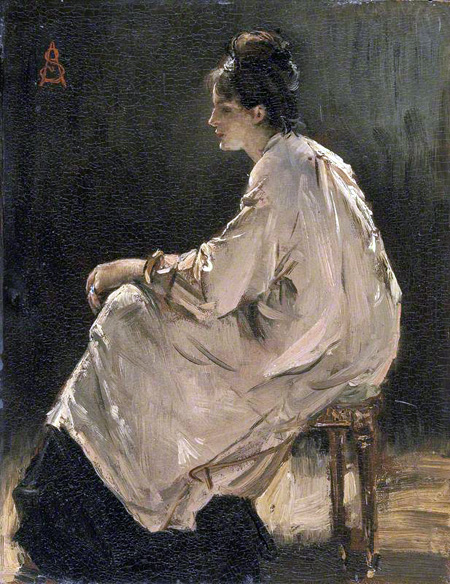
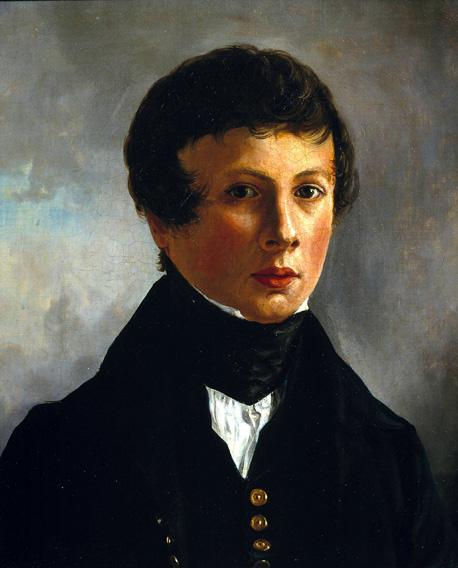
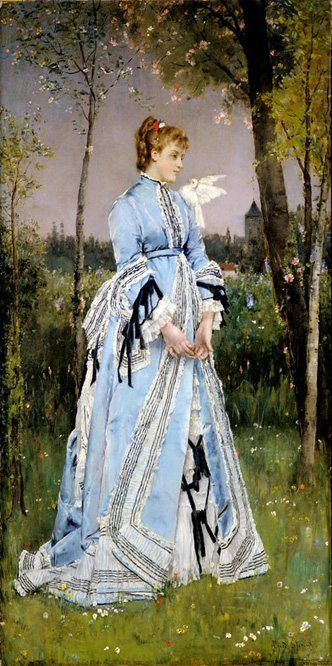
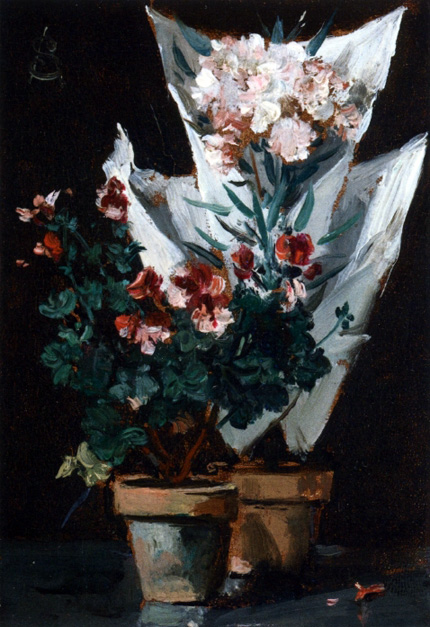

From 1880 Stevens made regular trips to the Normandy coast for the sake of his health; he suffered from a bronchial condition. The subject of this painting was recorded on a photograph in the artist's possession as 'Bad Weather at Honfleur'. The bold and spontaneous way in which this is painted suggests that, like many of his contemporaries, Stevens was influenced by the vibrant seascapes of Corot.
Quoted From: Storm at Honfleur - The National Gallery, London
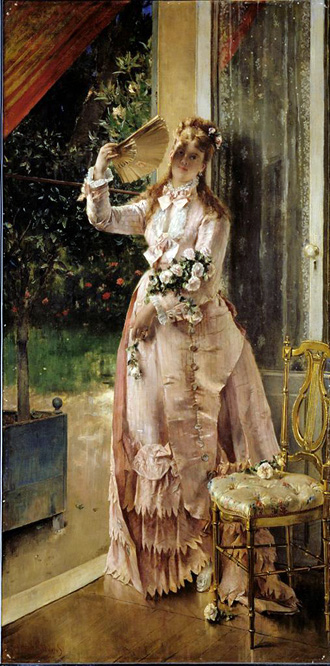
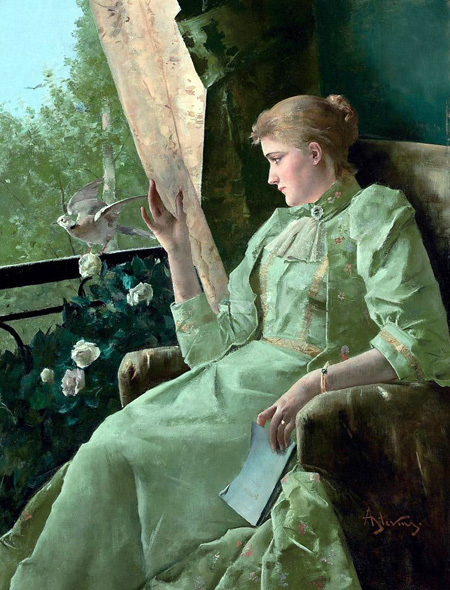
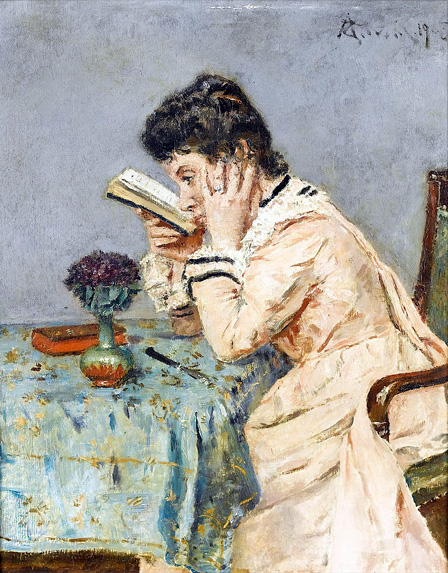

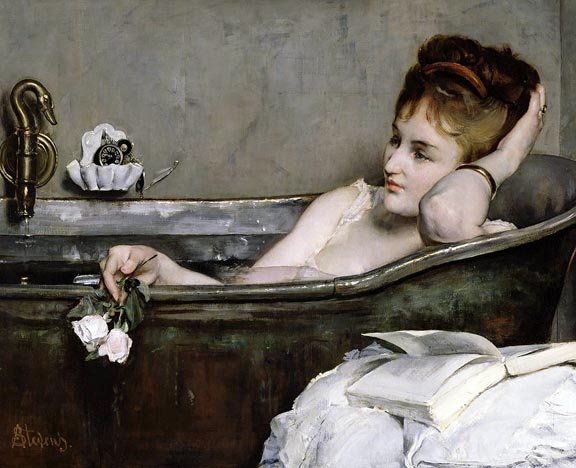
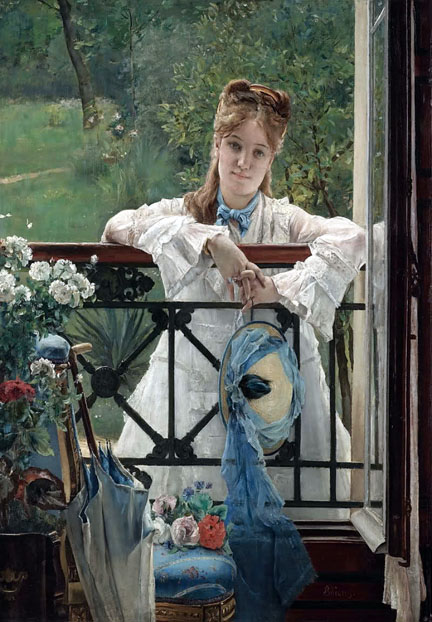
Stevens and Manet had formed a close friendship in Paris and often played dominoes in the Café Riche on the Boulevard des Italiens. Stevens' admiration for Manet was reciprocated by the Frenchman who once remarked, 'Yesterday I saw at Hoschede's a superb Stevens, please pass on to him my sincere compliments'.
Similarly to Manet's paintings of Parisians, Stevens' depictions of elegantly dressed ladies in fashionable attire were a record of his times. Stevens was well connected and his close association with the highest echelons of Second Empire society meant that even such social luminaries as Princesses Mathilde and Metternich often lent him dresses for his models.
The Blue Ribbon has no particular narrative yet is not without context. The bouquet of roses placed in front of the girl and the vivid palette used to depict her dress, hat, parasol and the garden behind evoke the innocence of a young life about to enter adulthood.
Quoted From: Alfred Stevens, Belgian 1823-1906
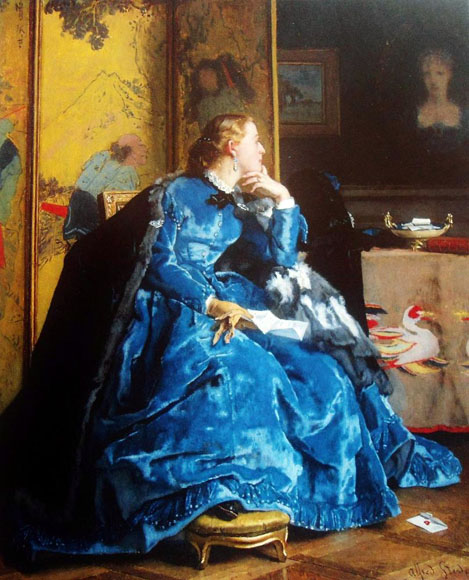



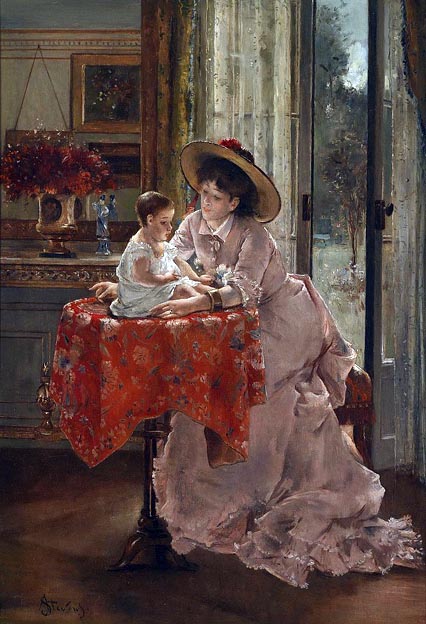
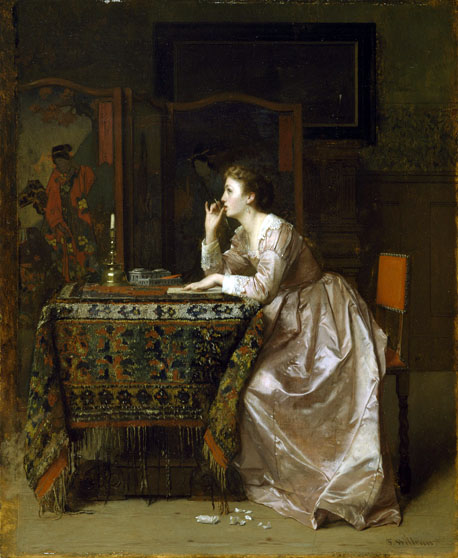
A lady in early 17th-century attire is seated at a table pondering a letter she is writing. In the background is a high Japanese screen. The artist has lavished great care in the rendering of the contrasting surfaces of his subject's satin dress and of the rug covering the table. In its intimacy and in its oriental note, this work approximates the painting of Alfred Stevens.
Quoted From: The Important Response - The Walters Art Museum
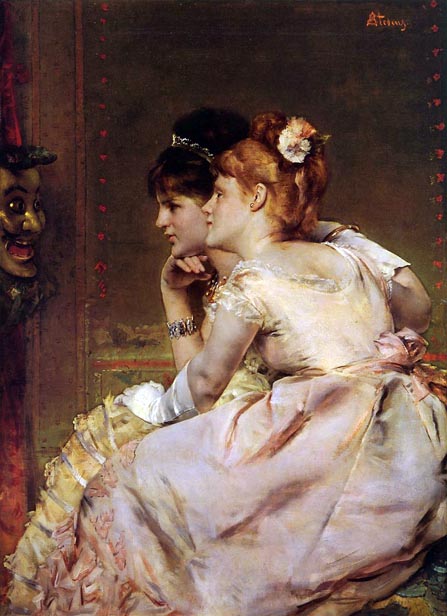
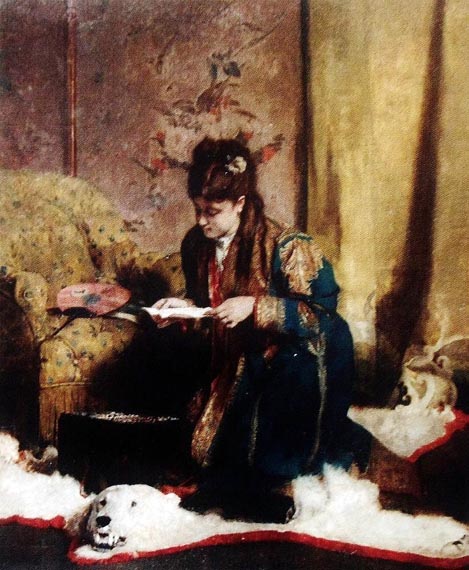
A young lady read a letter from a jewelry box by the Belgian artist Alfred Stevens (1823-1906) - Brussel:Charliermuseum (Belgium)
Quoted From: Alfred Stevens - Art
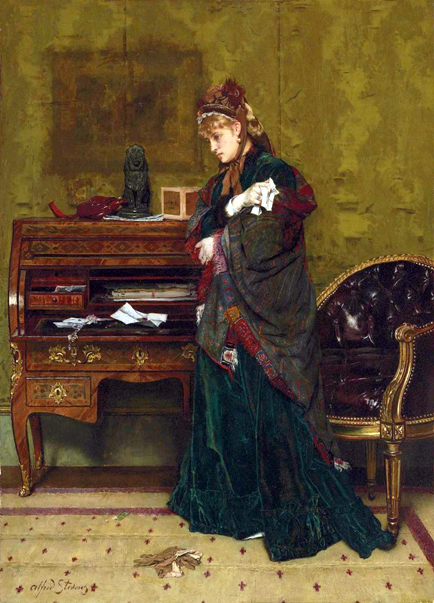
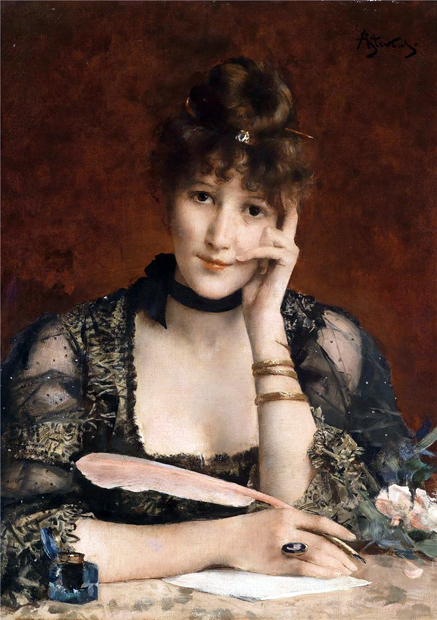
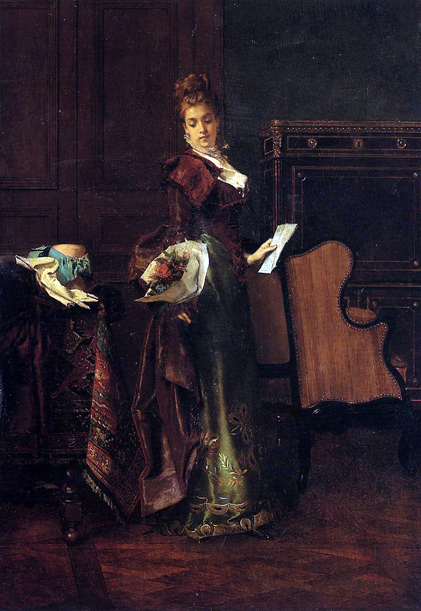

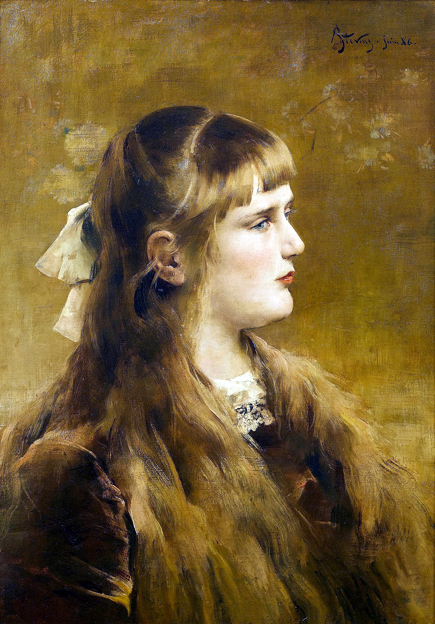
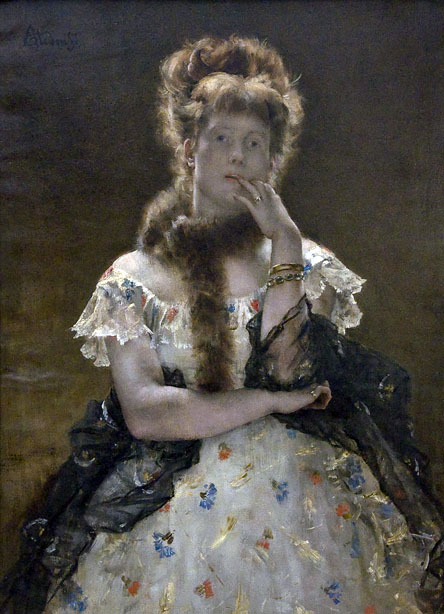
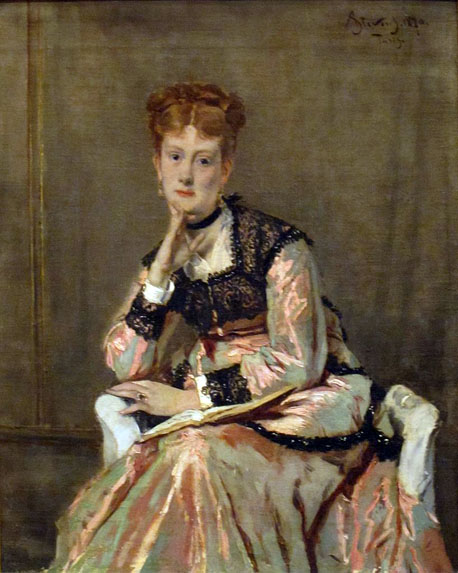
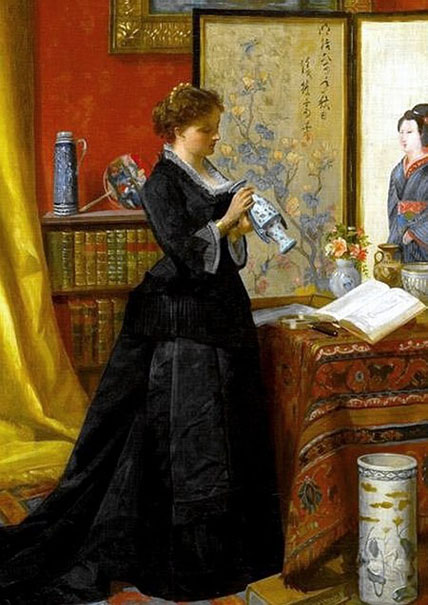
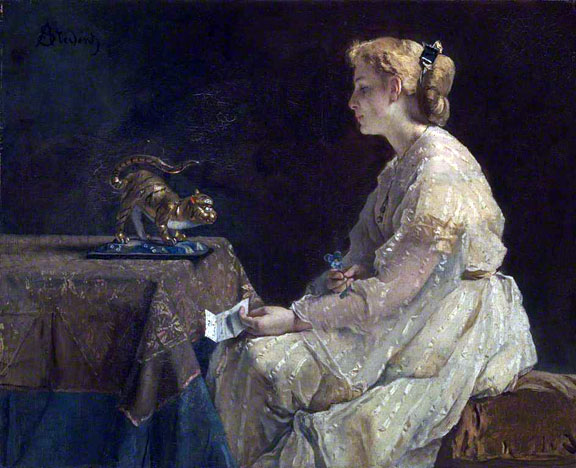
Stevens specialized in paintings of fashionably dressed young women. This picture, with its modest scale and intimate subject, is typical of his work.
The artist painted this subject on at least five occasions. One version was exhibited in 1866 but this one appears to be later.
(I am not sure about the dating of this painting. There seems to be some confusion, so I am not sure. ~ Senex)
Quoted From: The Present - The National Gallery, London
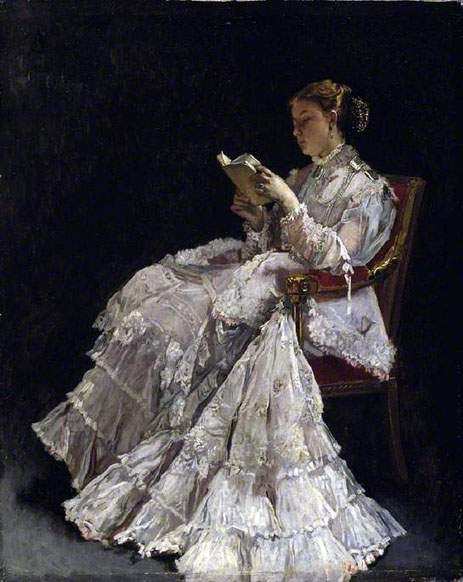

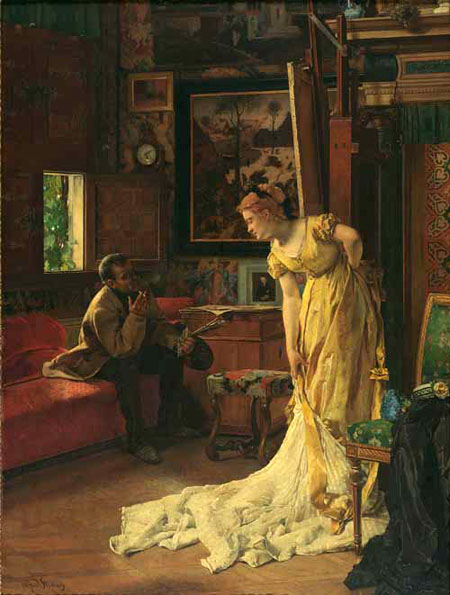
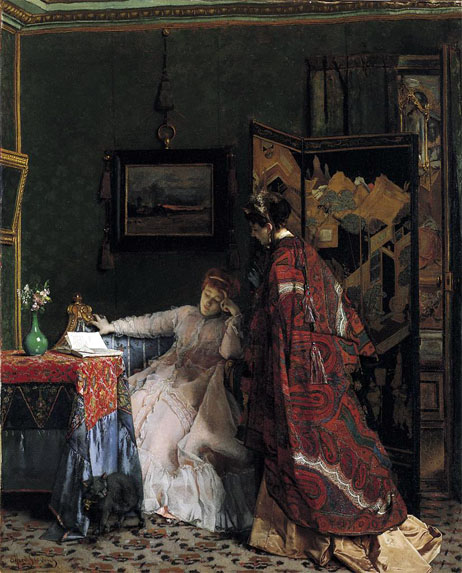
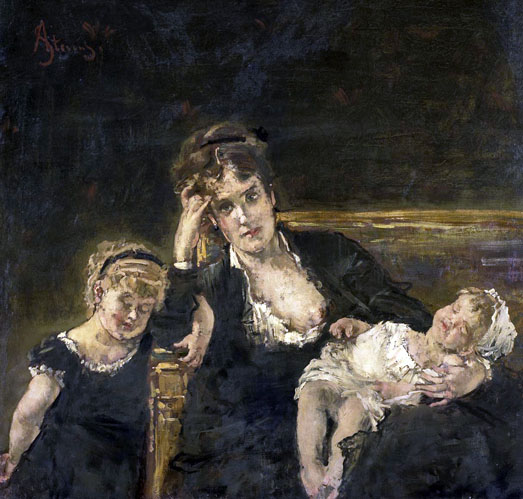
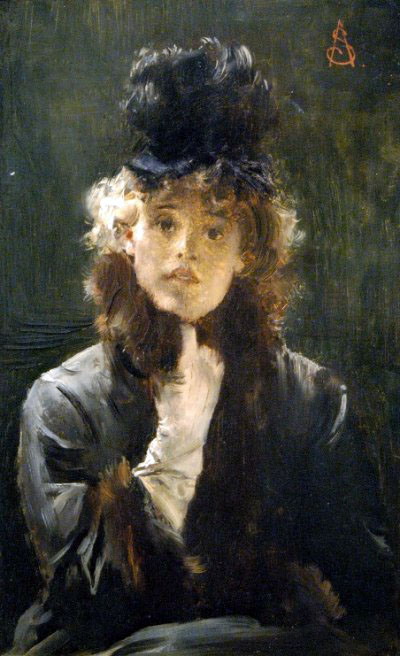
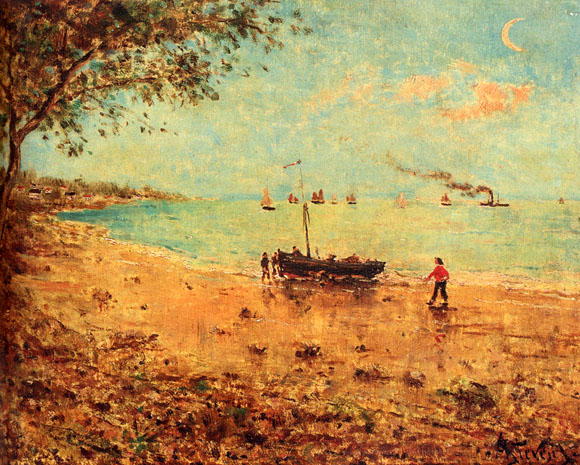
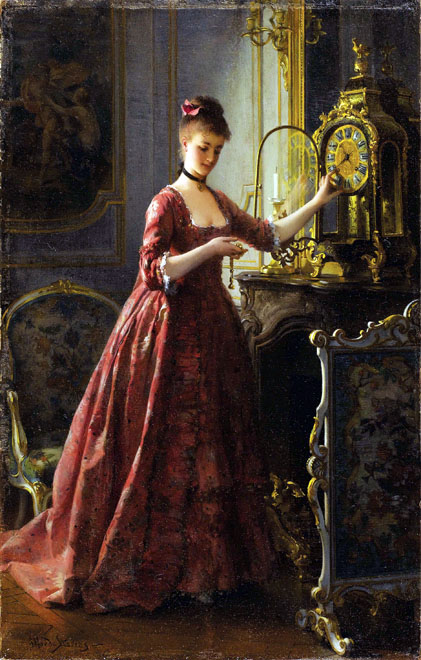
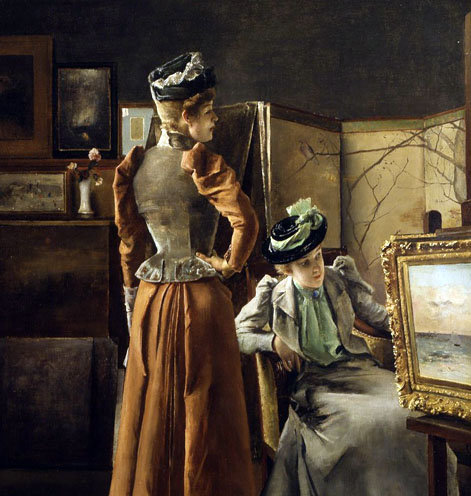
Alfred Stevens was one of the first painters to respond to the European fascination with the art of Japan. He did not adopt their stylistic modes but incorporated Japanese objects, often from his own collection, into the décor of his paintings. At the right of this studio scene is a Japanese folding screen typical of the many panels that found their way into European interiors.
The two well-dressed visitors are viewing one of Stevens' own impressionistic seascapes, a painting on the progressive edge of a career that manifested a lingering commitment to more traditional academic art.
Quoted From: Visit to the Studio - Indianapolis Museum of Art
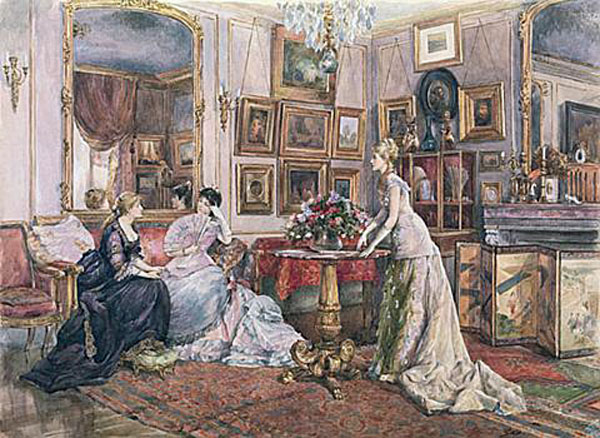
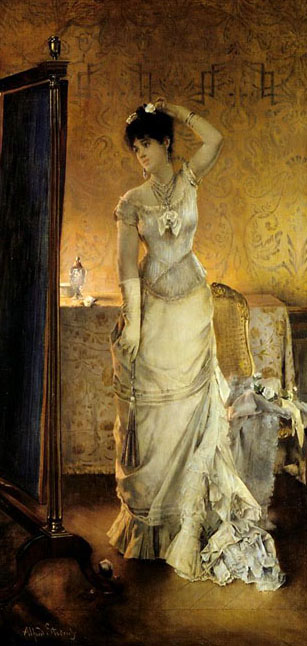
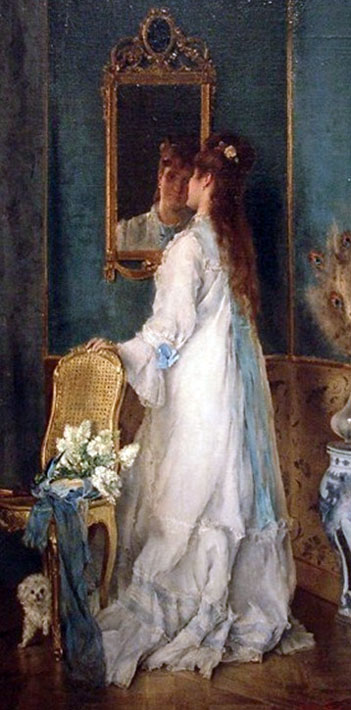
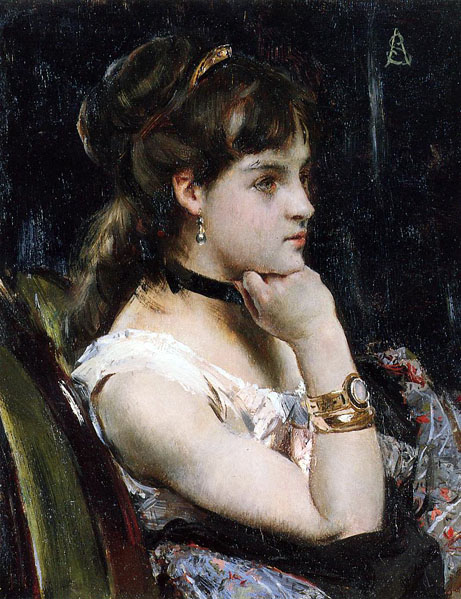
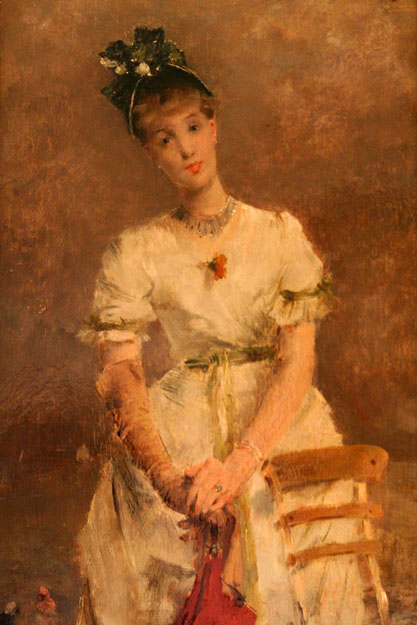

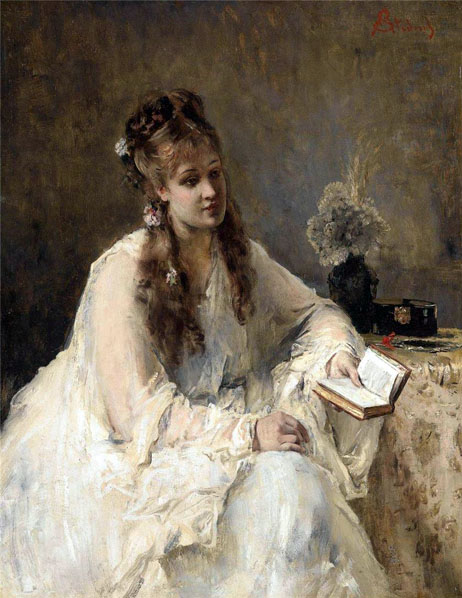
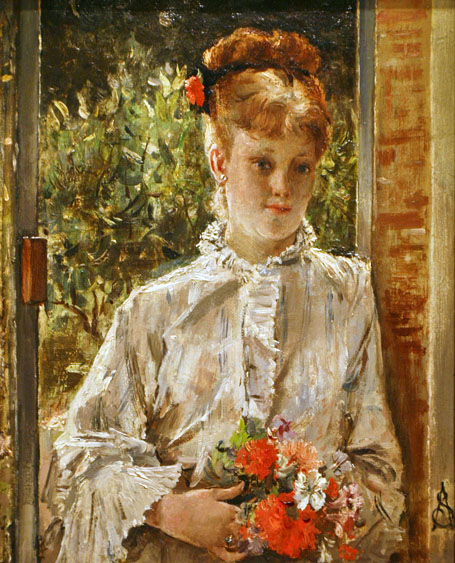
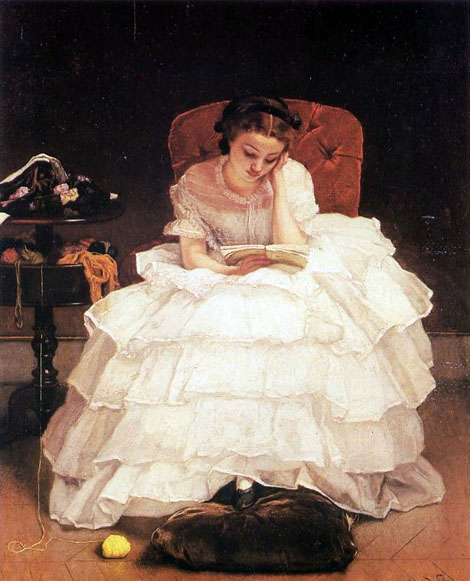
Return to Pagina Artis
Return to Bruce and Bobbie's Main Page.